Movie Review By: SFAM
Year: 2005
Directed by: Ben Steele
Written by: Darren Dugan, John Pinckney, & Ben Steele
IMDB Reference
Degree of Cyberpunk Visuals: Very High
Correlation to Cyberpunk Themes: Very High
Key Cast Members:
Leda Nea: Xi
Goho, Mary Nea: Molly Pinckney
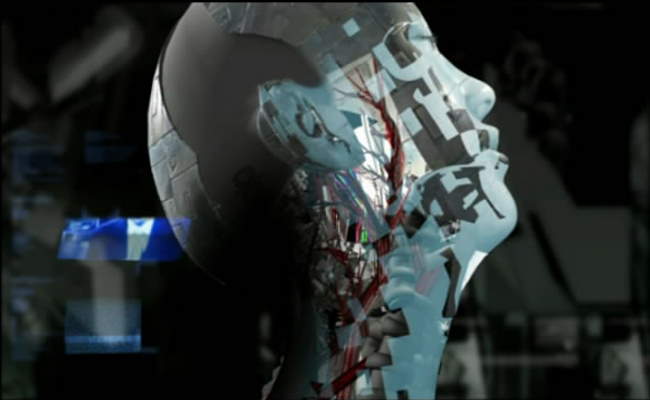
Fragile Machine - a Cyberpunk Operetta: If there was ever such a thing as a cyberpunk operetta, Fragile Machine is it. Fragile Machine is an indie anime film short created by a very small organization of talented artists called Aoineko. Fragile Machine’s narrative is largely told through haunting Chinese and English vocals set to a rhythmic, keyboard-laden techno beat (you can hear the main track by clicking on the aoineko link above). The combination of mind-expanding surreal android images with Aoineko’s music provides an intensely immersive experience – one which slowly envelopes your senses until you are a participant on Leda Nea’s journey. Fragile Machine is divided into six distinct chapters, and is narrated by a small android girl named Goho.
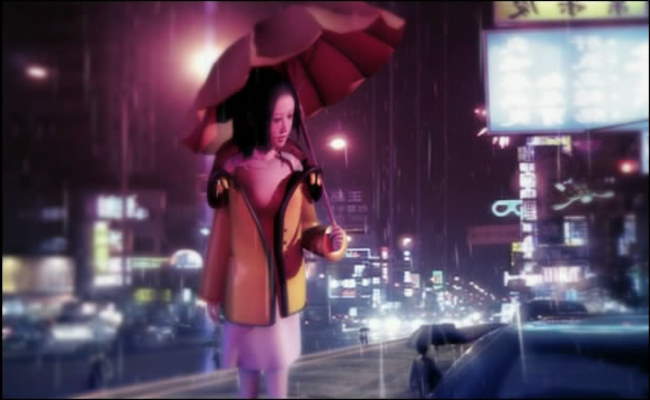
The Story: Leda Nea, a lead scientist heading up android firm, Göln Remedios’ Project Zero, is distraught over the death of her daughter, Mary. She no longer is interested in living, and decides to sign away her rights to be become a test subject for Project Zero. Leda Nea agrees to have her consciousness inserted into an android body, but the experiment goes horribly wrong, and Nea’s consciousness is permanently trapped in the android. A year goes by and Leda Nea becomes Göln Remedios’ primary work. Leda Nea has lost all sense of her former life, but still realizes she is trapped in a antiseptic prison – one which she desperately wants to escape.
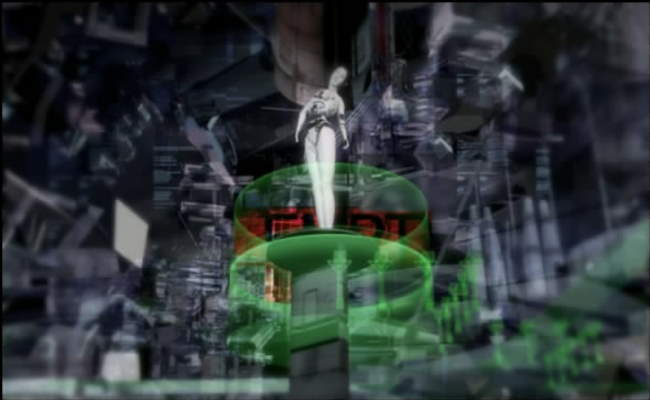
Eventually Leda Nea finds a way to trick her captors by using some of the android shells as decoys. Allthough still pursued by Göln Remedios’ droids, she escapes to the woods, and, surrounded by nature, begins to remember her humanity. In doing so, Leda Nea remembers that she hates herself and her very existence, and finally begins to remember the daughter she has lost. She continues to be pursued by Göln Remedios’ drones, but instead of getting captured she throws herself into a lake, and thus destroys her android body. At this point, her soul frees itself from its android host and embarks on an entirely new journey – one which could potentially provide Leda Nea salvation by connecting her back with that which she lost. While the ending chapter is visually astounding, I can’t go further without giving away the rest of the story.

A Post-modern Narrative: One one level, Fragile Machine appears to be a straightforward narrative in that it is explicitly divided into six chapters. Yet in watching this film, it becomes clear that the narrative is anything but straightforward. To understand the story, the viewer must pay close attention to the symbols, lyrics Goho’s commentaries, and the various visual indicators sprinkled throughout the film. While lasting just over 30 minutes, those interested in understanding the message will definitely benefit from giving Fragile Machine multiple viewings. The third time through, I found myself freezing the screen on a number of images in order to understand their significance. The story summary above is the result of watching Fragile Machine a number of times prior to piecing this all together. For instance, only very late in the film do you find out that Leda Nea is project manager of Project Zero, and is thus, responsible for her own destruction.
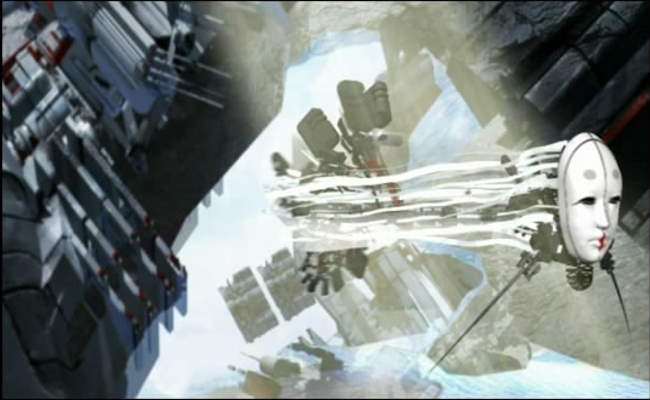
The Visuals: Even if you don’t care to spend time understanding the rich story and symbolism, Fragile Machine’s android visuals alone are well worth the cost of the DVD. Fragile Machine comes at man-machine integration and android creation and destruction from such a myriad of directions that it leaves the viewer in a state of wonderment. Through the film, color palettes are linked with the various symbols portrayed in Fragile Machine. Visual Homages are paid to a myriad of sources including Blade Runner, Metropolis, Ghost in the Shell and Planet of the Apes.
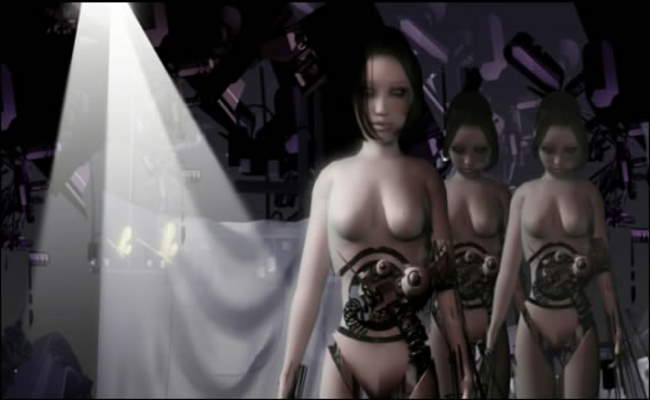
Animation Issues: While the artwork in Fragile Machine is intensely creative, the CG movement is definitely subpar when compared to some of the larger budget works. When Leda Nea is running, or the puppet narrator, Goho, is talking, the quality of the animation negatively affects the immersion. Depending on how you come to see Fragile Machine, this might be enough to turn you away from this incredible picture (perhaps this accounts for the insanely low score on IMDB). However, I would argue that the animation is only a minor knock in an otherwise perfect film short. In looking at the immensely small crew involved in making Fragile Machine, they pretty much nailed all aspects of this film that didn’t require massive CG animation engines. The post-modern story, the artwork and the music are all par excellence.
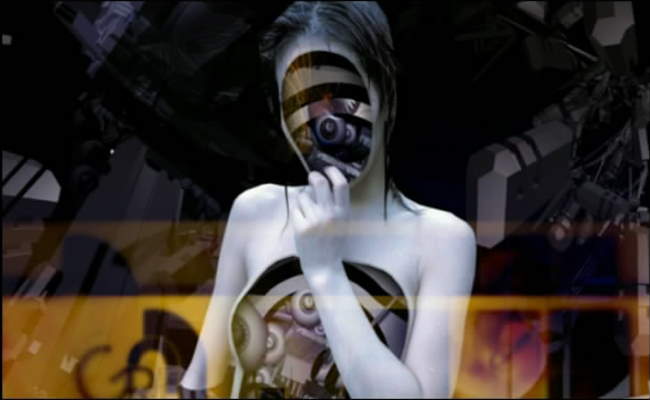
Interpreting Fragile Machine: Fragile Machine is visually and symbolically rich enough that the viewer can extract a number of fascinating thoughts. However, the larger point that Fragile Machine traces is a common cyberpunk theme - the idea that humans, in its pursuit of technology believes they will become omnipotent, with power over life and death itself. Yet in pursuing this course, we end up losing that which defines us – our humanity. Eventually, this pursuit of the taboo ends up destroying our very society. In a wonderful review of Fragile Machine, Jens points out that the corporation developing the androids, Göln Remedios, is visually similar to the Tower of Babel – both are stretching to the heavens in order to become God’s equal.
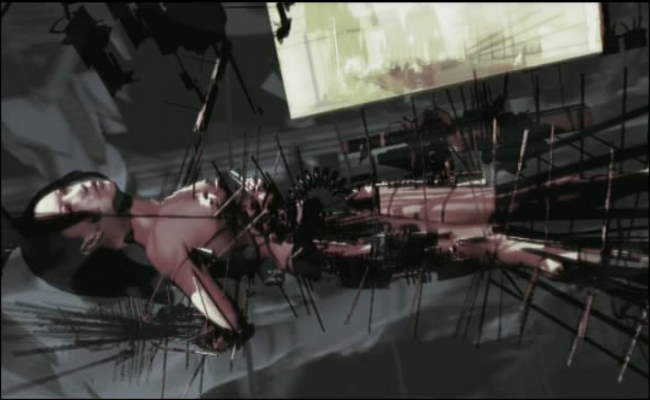
When we find out that Leda Nea is in fact the Lead for Project Zero, the emphathy shifts from a rather simplistic view Göln Remedios’ evil CEO figure being responsible to a far richer view. Leda Nea, in losing her daughter has lost her humanity, and thus no longer feels compelled to remain “human.” Her decent into subverting humanity starts well before she is captured in an android body. It begins with her work to build project zero – a project which at it core attempts to extract humanity and incarcerate it within a machine host. One almost wonders if Leda Nea initiated Project Zero in response to her daughter’s death. While the evil CEO is clearly interested in using Leda Nea as a tool in attaining virtual Godhood, it is Leda Nea who chooses to become the virtual fallen angel (as depicted by her red hue much of the time during her android descent). But ultimately, Fragile Machine becomes a story of redemption, as Leda Nea’s lost daughter, as represented by the elephant doll, becomes her guide towards finding ultimate salvation.
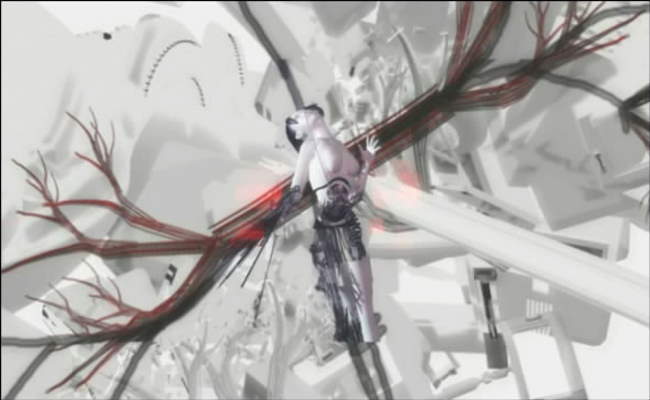
If an Android had a soul, what would happen to it when it dies? One of the more interesting questions Fragile Machine raises is the idea that if an android had a soul, what would happen when it dies? In pursuing this thought, Fragile Machine operates in the same territory as Ghost in the Shell, in which a human soul is essentially trapped within an android body. But the thought it raises can easily be taken farther than this: as we move ever closer towards sentient machines, what exactly becomes the difference between machines and humans? If machines become sentient, could they not also develop a soul? And if so, can this soul exist in some fashion even after its host has died?
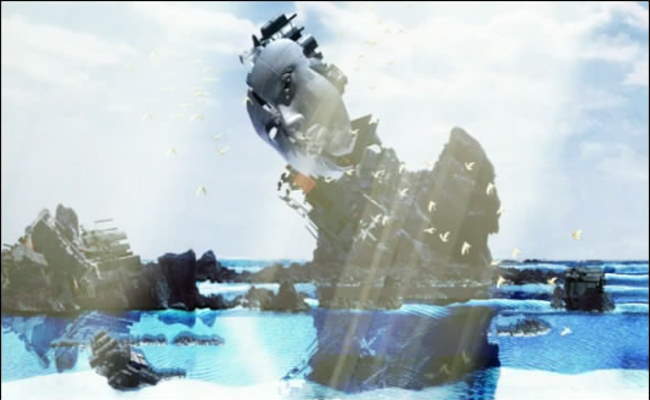
What Does a Human Mask Represent? Similar to f8, Fragile Machine uses a mask of a human-looking face to represent the attainment of humanity. Only in this case, the mask represents humanity’s technology enabled drive to create post-humanity – androids in our own image. Interestingly, this interpretation masks when viewing the last chapter of Fragile Machine leads to an interesting conclusion about the pursuit of post-humans. One wonders whether it is possible to pursue sentient androids in a way that does not explicitly challenge God’s (or nature’s) sacred role over life and death. Fragile Machine almost seems to be advocating an evolutionary, emergent approach over an overt, dominating, dehumanizing approach.
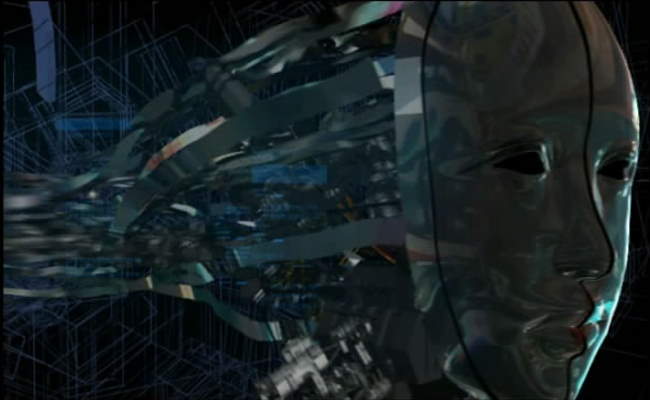
The Bottom Line: Rarely do we encounter a film so creative in its development, where the sounds and visuals are inexorably linked in expressing such an interesting story. While the animation isn’t on par with larger scale productions, the songs and visuals more than make up for it. In totality, Fragile Machine conveys a complex, multi-layered story that is rich in symbols and ideas. This is truly a piece of cyberpunk art not to be missed. The DVD was out of print but is available again (see in the comments section for details). Give it a try if you’re looking for something different.
Spoiler Alert! Page 2 has more screencaps, but some relate to the ending –>>
~See movies similar to this one~
Movie Review By: SFAM
Year: 2003
Directed by: Andy & Larry Wachowski
Written by: Andy & Larry Wachowski
IMDB Reference
Degree of Cyberpunk Visuals: Very High
Correlation to Cyberpunk Themes: High
Key Cast Members:
Neo: Keanu Reeves
Morpheus: Laurence Fishburne
Trinity: Carrie-Anne Moss
Agent Smith: Hugo Weaving
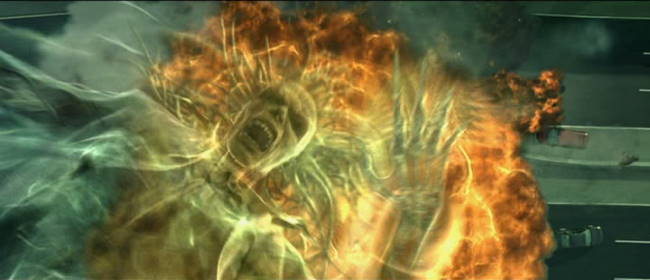
Overview: Matrix Reloaded, one of the most anticipated movies of 2003 provides a very interesting follow-up to one of the best, most influential movies in cyberpunk and all of Sci-Fi. Many have knocked this (and Revolutions more) for being a significant step down from the original movie, and to an extent they are in that the “newness” of the idea has worn off. But truly, it would be absurd to expect the Wachowskis to not use the universe they have already painstakingly created. In this sense, the sequels HAVE to provide a different sensation. In this sense, Reloaded does not disappoint. We get great performances by the Matrix leads, along with a number of truly terrific supporting roles. For this review, I’ll try to concentrate my comments more on the Sci-Fi aspects of the movies versus the religious narrative, as this also covered wonderfully elsewhere. I’ve also tried to use less well known screencaps on the first page of this review. To see some of the more popular Reloaded screencaps, go to page 2 of this review. Also, this review goes in line with my more in-depth assessment of the trilogy from a SciFi perspective:
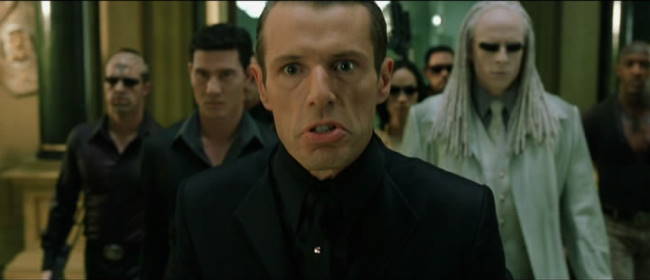
No “The Matrix Sucks/No It’s Great - You Just Don’t Understand!” Debates: Just a fair warning – if youre expecting Matrix sequel bashing, I’m afraid you’ve come to the wrong site. There are numerous places to read such banter if you’re interested. I absolutely love the sequels for a variety of reasons (some of which I explain below), but I really don’t mind in the least if you hate the sequels. Yet, for this movie, I’d really like the comments on this entry to be more related to the movie itself versus whether or not you hate the sequels. Believe me when I tell you I’ve participated in many more hours of discussion on this topic than I ever care to, and absolutely will not get into this in the comments section of this review. If you MUST engage in the “Matrix Sequels Suck/No - They’re Great, You Just Don’t Understand!” debate, please use this thread in the Meatspace.
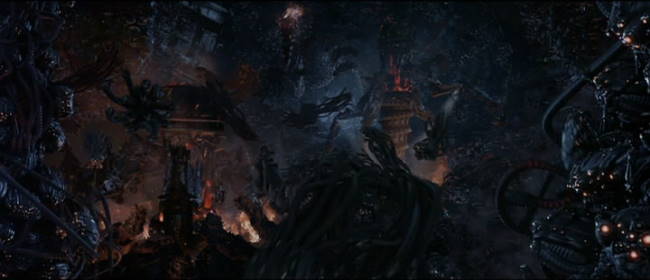
The Story: I’m going to go out on a limb here and guess that about 99.9% of you reading this review have already seen Reloaded, so I won’t spend much time on an overview of the story unless its specifically requested. In brief, Matrix Reloaded is the sequel to the Matrix, and is the second of three movies in the trilogy. In Reloaded, six months have past since the end of the Matrix, during which time, Morpheus, Neo and Trinity have been busting hump freeing massive numbers of battery people. In Reloaded, we get to see Zion, a return of Mr. Smith, and eventually, a fuller understanding of the nature of the Matrix and the Prophecy of the One.
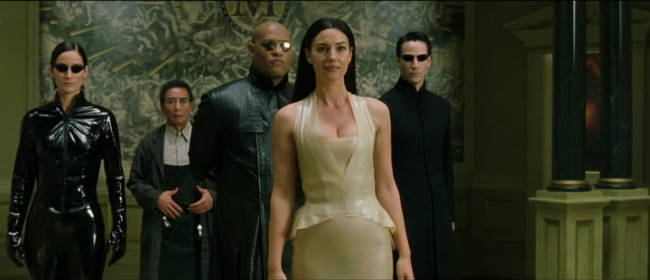
The Supporting Characters: One of the real strong points of Reloaded is the cool character additions. The best ones are of course the Merovingian (played magnificently by Lambert Wilson) and Persephone, played by the ultra-sexy Monica Bellucci in a totally hot see-through dress. When they are onscreen, both absolutely steal the scenes. Almost as terrific is the Architect (Helmut Bakaitis) and the blasé evil ghost twins (Adrian and Neil Rayment – who actually are twins) – they have to be up there as some of the best henchmen ever to grace the screen. Seraph (Collin Chou), Councilor Hamann (Anthony Zerbe), Link (Harold Perrineau), the Keymaker (Randall Duk Kim), and Niobe (Jada Pinkett Smith) all really add to the movie as well.
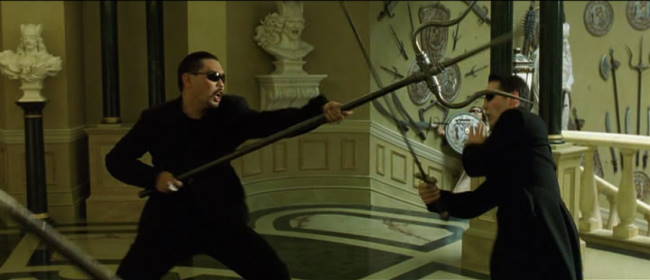
The Action: Reloaded is filled to the brim with awesome action scenes. In addition to some wonderful Woo-ping Yuen choreographed fights, we get one of the best highway chase scenes ever put on film. The Trinity motorcycle part in particular is just awesome. Truly though, serious credit has to go here to Keanu Reeves’ preparation and training for this film. By all accounts he was an absolute machine in terms of preparation. It really shows on screen. His wire work and martial arts scenes are just terrific (And no, I’m not comparing him to those in Hong Kong who’ve spent an entire career doing this stuff). The CG for the most part is absolutely top notch.
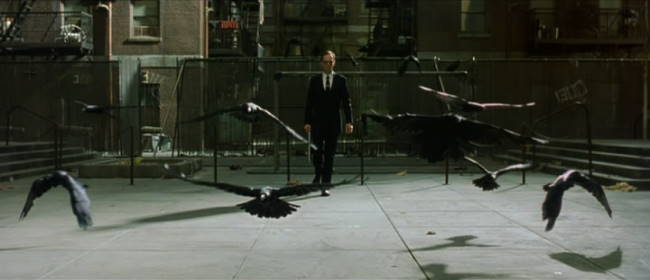
The Visuals: Matrix Reloaded has a lot more diversity in its visuals than the Matrix provided us. We have a few experimental shots like the graphic novel scene of Neo flying with the Moon behind him – and lots of yellows and greens. For yellows, we get rave scenes, explosions, and fights in a yellow weapons room. Greens, of course, still dominate the majority of the scenes – like the first movie, they are omnipresent in most low-light scenes. All in all, the visuals are incredibly diverse and interesting.
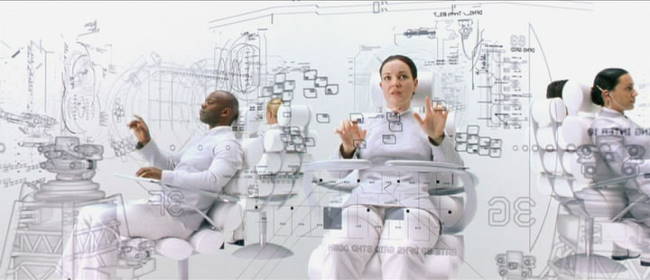
The Pacing: Matrix Reloaded starts off with a bang (literally) before getting into the story. We get a mixture of plot discussions, action sequences and philosophical breaks. But Reloaded is as a whole is definitely of a different style pacing than most movies. It and its sequel more closely resemble the approach taken in Oshii’s Ghost in the Shell, where there are philosophical and thematic discussions that are then played out in the action sequences. The ending clearly comes off as a cliff-hanger, which is to be expected considering this is the middle of a trilogy.
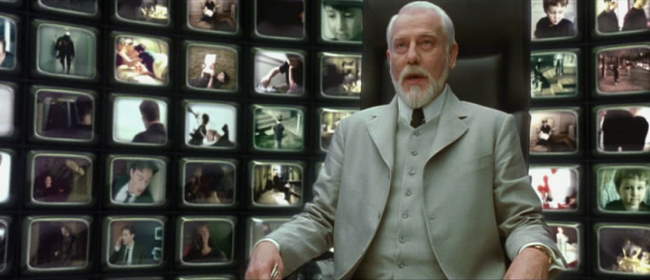
The Architect Conversation: The Architect conversation provides some of the best dialogue of the entire trilogy. This is a philosophical break, a plot buster, and more importantly, the major turning point in the trilogy. The Architect and his minions serve as the ultimate representation of a negative feedback (negating change from an initial goal state) control system. His whole purpose in life is to ensure a steady supply of power (electricity) to the Machine City. As the power is created off the electricity in humans, the Architect must develop a plato cave-like virtual reality simulation that provides humans with a believable reality. The Architect reveals the details of the control system that has kept the machines satiated with electricity for the past 600+ years. In this we find that the prophecy of the One is merely one more layer of control to maintain the status quo to handle the problems arising from freewill (more on this below). Unfortunately, something (or someone) has thrown a monkey wrench into his carefully laid plans. Neo has fallen in love, and in so doing, creates a personal connection with a human that is potentially larger than his overall connection with humanity.
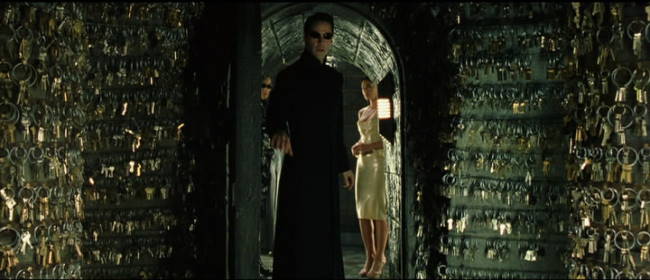
Freewill: Matrix Reloaded spends a good bit of the philosophical breaks discussing the impact of freewill on actions, decision making and on control systems. The Merovingian assets that without the “why,” freewill is merely a facade by those in power that is placed on the powerless. The architect who created the Matrix based on mathematical equations. While he has accounted for almost all anomalies, he had to develop a special periodic subroutine to address the issue of freewill. Because a very small subset of the population would reject the Matrix programming, there needed to be a way of handling this. His approach involves the creation of an external holding bin called “Zion,” which which he would let fill up with the problem battery people, and then every hundred years or so would clean out the holding bin and start again. Simultaneasly, Morpheus, who is unaware of this freewill control subroutine, sees the prophecy of the One as a deterministic journey - one which both reduces the power of freewill while supposedly saving Zion.
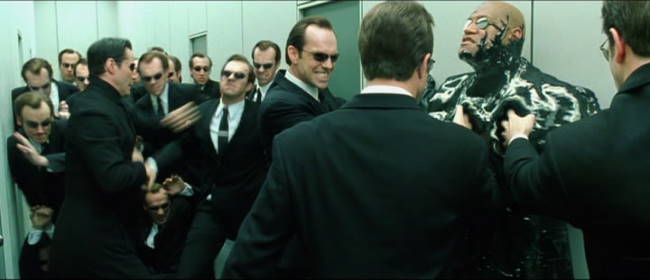
Positive Feedback Out of Control: From a cybernetic standpoint, Positive feedback, or the deviation from an initial goal state, plays a huge role in both reloaded and revolutions. In fact, both movies constitute an emergence and interplay among dueling feedback systems. The architect has created a negative feedback system that has been in force for at least 600 years. Yet now, the perturbations to the negative feedback control system are systemic – in fact, they constitute an initial kick in an entirely new direction. The study of cybernetics tells us that negative feedback systems are destroyed – often never to be repaired to their original state – if the upper or lower threshold values in the are exceeded. For instance, if the body temperature in a human exceeds 106 degrees Fahrenheit, the human will die. In the futuristic dystopia of the Matrix, this is the strategy the Oracle takes. The rationale is that unless the architect’s control system is rendered moot, the “ebony and ivory, living in perfect harmony” future (with machines and humans) the Oracle desires cannot occur.
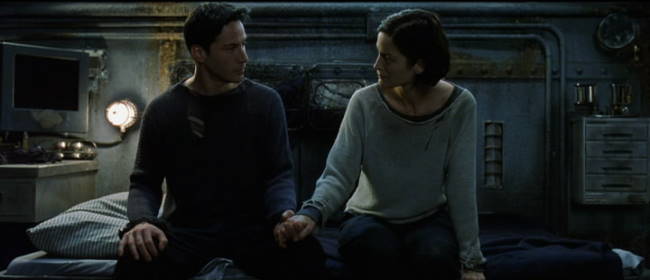
Elements of the positive feedback system, represented in totally by the Oracle and the causality she creates, include both a modification of Neo’s operant conditions and an intrusion into Mr. Smith’s deletion. Neo’s love for Trinity changes the outcome of the Architect’s freewill subroutine – instead of having only one real choice (saving humanity), Neo has a new choice – save trinity now and spend 24 hours trying to rescue Zion and humanity or continue with the control system which will wipe out Zion. Additionally, Mr. Smith has been transformed into a virus. When Neo destroys him in the first movie, Mr. Smith did not disappear – instead (as we find out in Revolutions), the Oracle intervenes and creates the new, viral Smith. While there is no resolution to this in reloaded, the context is set for the resolution in Revolutions.
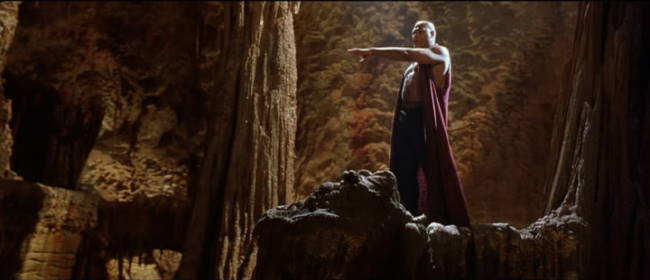
I Believe…: I believe this phrase (“I believe”) is used twenty times or more in Reloaded. There are times it fits perfectly, whereas others it seems to interfere with the dialogue. The scene where Commander Lock is discussing strategy with the Council is the most egregious example of this. Versus “I believe we need every ship…” it would have been far more realistic had he used a simple “We need every ship if we are even to have a chance…” The problem of course is the whole issue of whether or not the Commander and Council believe in the Prophecy of the One. As impending doom draws nearer, the tendency to place faith in supernatural explanations for salvation becomes too great to resist.
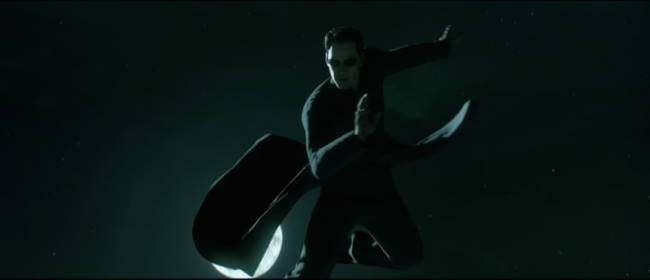
The Bottom Line: The Matrix Reloaded is a terrific follow-up to one of the most influential movies ever. The Wachowski brothers have provided a movie where the action is terrific, the characters are memorable, and the narrative is complex and interesting. Lawrence Fishbourne as Morpheus in particular shines here, which is great, in that is role is significantly diminished in Revolutions. While Reloaded suffers somewhat from being the middle movie in a trilogy, I think it handles this well. The ending provides us with a cliffhanger, which, at the time of release, sparked IMENSE numbers of interesting theories and ideas. I’m guessing most of you have watched Reloaded, so I feel strange giving a plug to watch it. All I can say is I love it.
Page 2: More Screencaps –>
~See movies similar to this one~
Movie Review By: SFAM
Year: 1997
Directed by: Takashi Miike
Written by: Itaru Era (screenplay), Hiroki Yamaguchi (story)
IMDB Reference
Degree of Cyberpunk Visuals: Medium
Correlation to Cyberpunk Themes: Low
Key Cast Members:
Kensuke Hagane: Tsuyoshi Ujiki
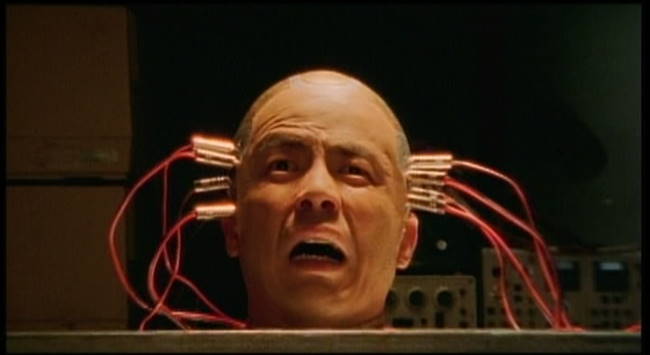
Overview: Full Metal Yakuza is simultaneously a campy low-budget Robocop Rip-off done with gangsters and an exercise in a mild form of extreme Japanese cinema. Director Takeshi Mike (best known for Ichi the Killer, but also did Andoromedia) does his trademark extreme blood spatters, and includes lots of head chopping, gun fighting, and a torture-rape-suicide scene thrown in for good measure. You won’t get any big picture thoughts out of this flick, but you might want to tune in for the crazy action and visuals.
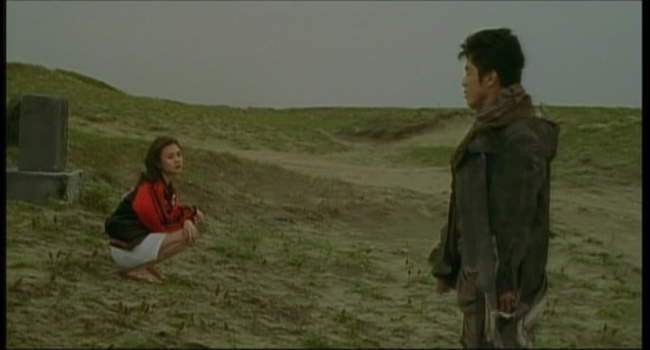
The Story: Kensuke Hagane (Tsuyoshi Ujiki) is a slacker junior gangster who doesn’t show a lot of potential. In his mind, he wants to be a Yakuza – a tough guy with a code that’s feared by all. Unfortunately, he just doesn’t have what it takes. He sucks at fighting, enforcement, and worse – he even sucks at love making. He idolizes the older Tousa, a gangster tough guy extraordinaire that has a detailed dragon tattooed on his back. After Tousa gets taken prisoner for 7 years, Hagane perseveres to become an enforcer. Unfortunately, when released, the Yakuza gang betrays Tousa and shoots him down – Kensuke gets killed in the crossfire.
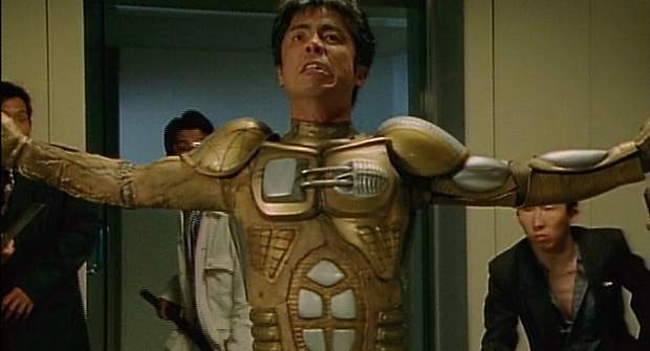
Then the weirdness begins – Hagane wakes up in a strange lab, and finds out that his head has been removed from his body and is now attached to a cyborg body, partially made up with Tousa’s remains. He has Tousa’s heart, hands, feet, tattooed back, and most importantly, his very large “member.” An insane genius scientist ((TETSUO’s Tomorowo Taguchi), for reasons never explained, has brought him back to life, but before Hagane agrees to work with the scientist, he must take revenge on those who killed him and Tousa.
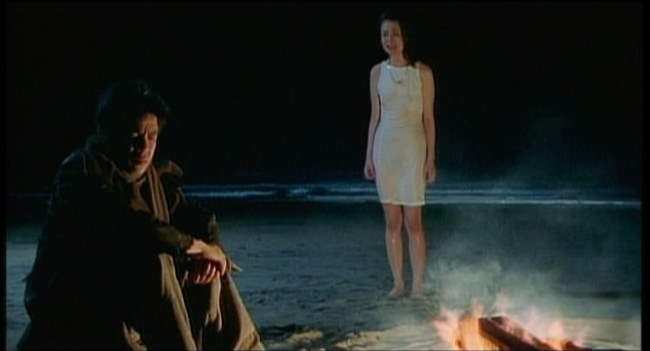
Hagane goes all out, killing his way to the top, but eventually stops due to the pleading of his former friend. Along the way, he also finds Tousa’s mistress (Shoko Nakahara), and falls in love with her. Things go horribly wrong when she is taken prisoner. Hagane now has to finish what he started.
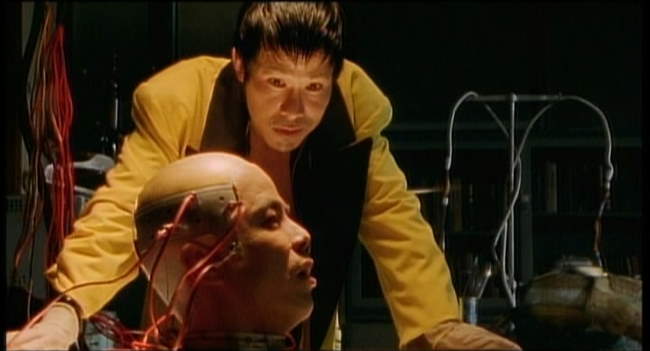
Yes, He’s a Cyborg, But…: Nothing in this movie should be taken too seriously, especially the cyborg aspects of this. Kensuke eats bullets and other assorted metals for energy, but apparently doesn’t even need to grind his teeth to chew them. His body is fully metal, but apparently he’s had an extra large dick grafted on as well. He does weird chants in order to temporarily turn off his emotions (apparently, this trips a jump switch of some kind). I could go on, but nothing in this depiction of cyborgs is intended to be anything other than the creation of a setting.
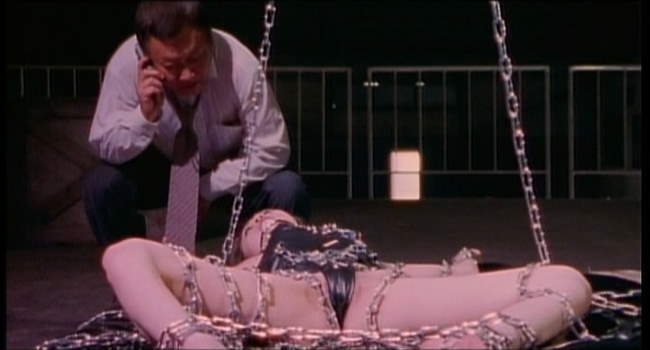
The Visuals: Full Metal Yakuza gives us a number of trademark Takeshi Mike shots, including massive screaming, gratuitous blood spurts shooting in all directions, torture and rape, and a variety of surreal action scenes. From a cyberpunk standpoint, the interesting visuals take place when Hagane is first transformed into a cyborg. In many ways, they resemble a lighter version of Android from Notre Dame’s visuals.
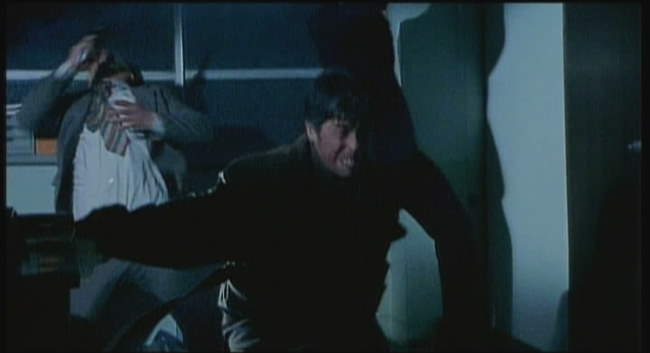
The Bottom Line: Full Metal Yakuza is interesting in that it was apparently made for a very low budget. There is enough here in terms of strange, extreme cyberpunk visuals that many might really enjoy this flick. Just don’t be expecting too much from the story. There are whole sets of scenes that go absolutely no where (the female cyborg chick, for instance), and many more that strain the bounds of coherence. But if you’re interested in watching a campy, extreme Japanese, non-sensical cyberpunk flick, you might want to give Full Metal Yakuza a try.
~See movies similar to this one~
Movie Review By: SFAM
Year: 2005
Directed by: Karyn Kusama
Written by: Phil Hay & Matt Manfredi
IMDB Reference
Degree of Cyberpunk Visuals: High
Correlation to Cyberpunk Themes: Medium
Key Cast Members:
Aeon Flux: Charlize Theron
Trevor Goodchild: Marton Csokas
Oren Goodchild: Jonny Lee Miller
Sithandra: Sophie Okonedo
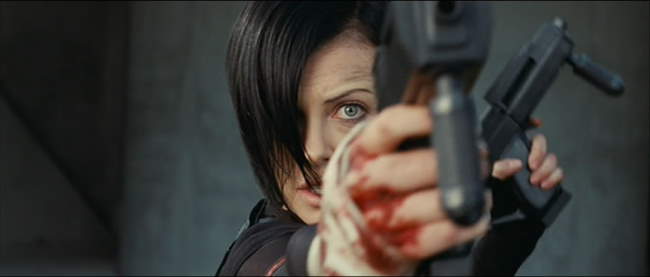
Overview: In the best of cases, remakes of cherished shows rarely turn out good. The MTV Aeon Flux cartoon series was an intensely creative post-modern show by Peter Chung, who broke all the rules of how narratives are supposed to be told. The lead character, Aeon Flux, the ultimate anti-heroine, dies on a regular basis; nobody was purely evil or purely good; and everything was high-tech body modification chaos. Unfortunately, the movie does away with all that. In an attempt to “humanize” the iconic figure of Aeon Flux, the movie version goes for a standard rebels-versus-Orwellian bad guys movie with a twist. While some of the visuals are absolutely terrific (including some wonderful action scenes by Charlize Theron), in the end, this is a very different story with very different characters, and must be understood as such.
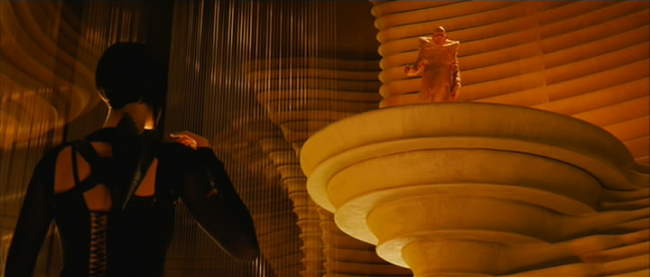
The Story: Aeon Flux takes place 400 years after a virus has devastated humanity, killing off 99% of the population. Now, one walled city named Bregna, holding 5 million people is all that remains of humanity. Bregna is ruled by a council of genetic scientists who have (supposedly) been avidly working on fixing the fallout of the virus for the past 400 years. For reasons only partially explained later in the story, the ruling council has instituted a totalitarian government with an extreme crackdown on personal freedoms, and have backed their authority with an intense surveillance apparatus. A group of rebels called the “Monicans” have challenged their right to rule, and have vowed to destroy the ruling council, especially their leader, Trevor Goodchild (Marton Csokas), at all costs.
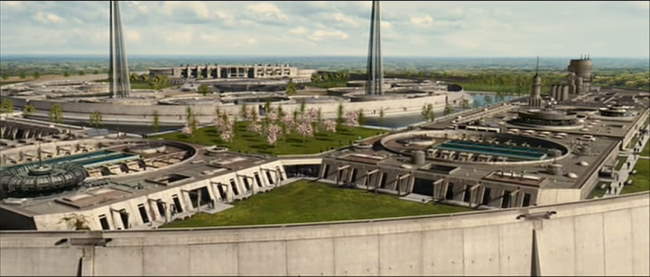
Aeon Flux (Charlize Theron) is the Monican’s very athletic, butt-kicking, black spandex wearing operator-extraordinaire. No mission is too dangerous, and no obstacle is insurmountable. In what serves as the prologue, Aeon’s last surviving family member, her sister is killed by the Bregan Council authorities – all that remains for Aeon is revenge and the mission. Finally her time comes when the fiery-haired Monican handler (Frances McDormand) authorizes her to go assassinate Trevor Goodchild. So Aeon and her partner with four hands and no feet, Sithandra (Sophie Okonedo), storm the garden and infiltrate the Brega Council compound.
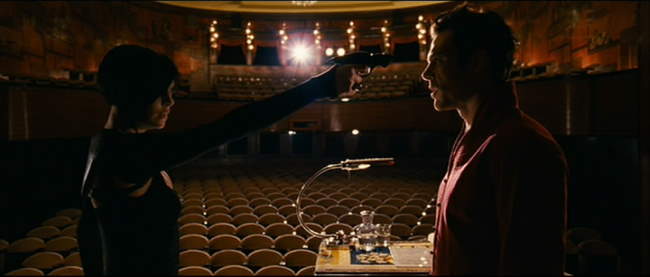
Unfortunately, as Aeon finally encounters Trevor, not all is at it seems. She suddenly has memories of kissing Trevor in a former life. Worse, it looks like there are other forces at work, and perhaps Trevor isn’t the bad guy the Monicans have made him out to be. As Aeon follows her heart and the ever expanding mystery, she engenders anger from the Monicans, while Trevor ends up at the wrong side of a coup-des-tat at the hands of his evil brother, Oren Goodchild (Jonny Lee Miller).
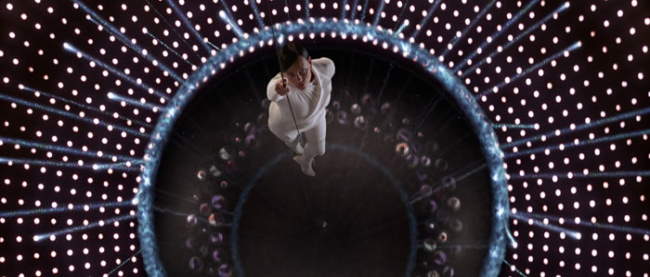
Story Problems: While the front half of the Aeon Flux story works, the back-end is riddled with inconsistencies. If you spend an ounce of time thinking through the motivations, the actions of the main bad guy make no sense. What he really wants (immortality) can be accomplished even Trevor’s experiments prove successful. This is muddied further when the Jurassic Park mantra, “Nature finds a way” is added to the mix. Even weirder is Pete Postlethwaite’s character, who comes across almost as the watcher in a Fantastic Four comic. We are never sure if he is real or Memorex. Worse, his final monologue where he explains his actions adds yet another strange element to the scifi-mix – precognition. In the end, there are too many fantasy-like technologies for this to come across as believable. In brief discussions with on the writers (Phil Hay), it appears that the original script might have been tampered with. I really hope this is the case, as the visuals of the movie were more than strong that they would work for even a passable story.
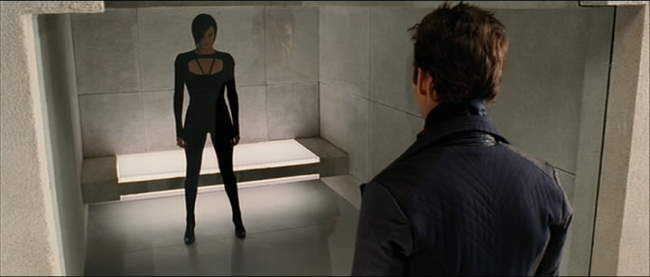
Changes With Aeon and Trevor From the Cartoon: The move version of Aeon Flux in no way matches the lead characters of Aeon Flux and Trevor. In Peter Chung’s cartoon, Aeon Flux comes across as the ultimate anti-heroine. While she clearly knows right from wrong, and generally tries to stop the worst abuses, Aeon is an ultra-acrobatic, top-notch action-espionage heroine who works for herself, and only operates under her own agenda. Trevor is a mostly malevolent, superior dictatorial character who as a true soft-spot for Aeon. For her, he will bend his approach, but otherwise he rarely is a nice guy. We rarely see fear, doubt, or self-loathing out of Aeon, although she too has an eternal love for Trevor that trumps all. Kusama’s version of Aeon and Trevor tries to humanize them, and in doing so, removes much of their uniqueness and appeal. New motivations and afflictions are created where none previously existed. Worse, their very nature changes. In the end, Trevor turns out to be a misunderstood hero who works valiantly to save humanity – his only fault is he turns a blind eye to his brother’s excesses. Aeon becomes an agent working for others goals, but only later turns to herself based on principled evaluation of what is right and wrong. Again, while both of these characters may be interesting if done well, they bare little resemblance to the mindset of the Aeon and Trevor characters from the original show.
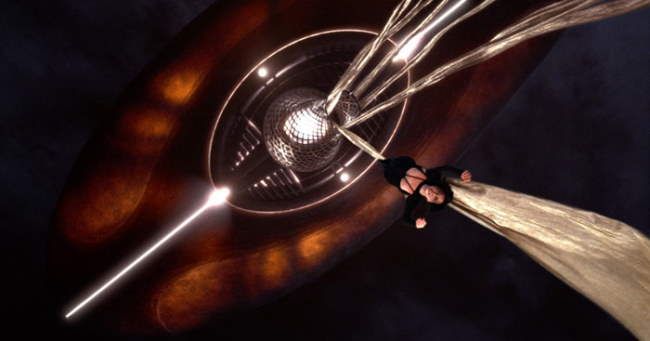
Still, I must give credit to Charlize Theron’s athletic feats in this movie. By all accounts she spent 3 months training to be a gymnast and fighter, and it shows. While for the most part she does away with the ultra skimpy clothes from the cartoon, she really does nail the gracefulness and style of the cartoon Aeon Flux. And while I don’t necessarily agree with the humanization approach, Aeon does pull this off very well, especially considering she has very little dialogue. The fact that she got seriously injured on the tenth day of shooting (herniated disc injury), but came back to continue the vast majority of the stunt work is a testament to her commitment and professionalness, and should be applauded. If I had one complaint with her protrayal, she really doesn’t really “look” the part, in that the cartoon character was a taller figure with a far more angular face and tapered hair.
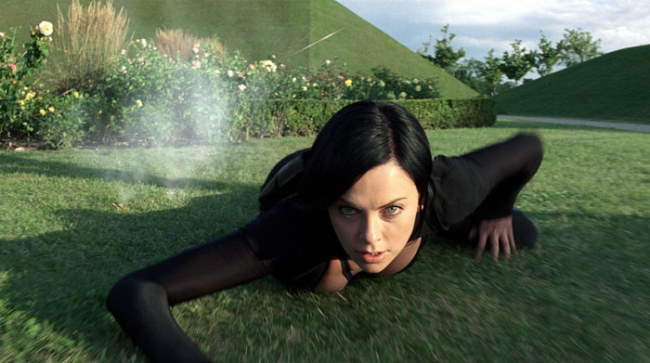
Editing is Way Too Frantic: Aeon Flux was a very contemplative animated show. Almost always, you had time to properly digest a scene. The atmosphere of the original series is largely based on the pacing. In the movie version, the editing seems designed to artificially hype the tension. In the end, it results in sucking the life out of many of the scenes. You rarely have time to feel connected to the scenes. More often, you feel like you’re riding a roller coaster, even when the scene is nothing more than two people talking.

The Technologies in Aeon Flux: The body modifications (such as hands replacing feet, and various stuff stored within the skin) in Aeon Flux really added to the visual appeal. Also, there were a number of interesting technological innovations. Probably the biggest was the peer-to-peer interaction in “brain space” that the Monicans use to elude the Orwellian-style surveillance systems that the council has set up. The flat metal slices that turn into semi-autonomous exploding balls were visually cool, as was the room that worked in two dimensions (each dimension of frequency holding completely different items). I also liked the bubbling Band-Aids that Aeon has stored, hiding on her skin.
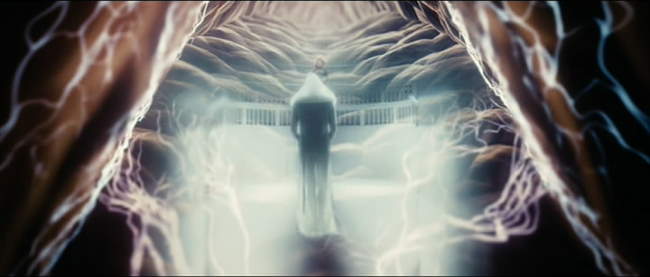
The larger technology involved cloning. In Aeon Flux, cloning equates to flawed reincarnation. With each generation the people are cloned, the memories of their lives somehow stay with their soul – yet with each time they are cloned, the new person has memories from the previous versions. Over time, the cloning ends up destroying each other’s reality. For the most part, I don’t think this idea worked all that well. It gets especially troublesome when we look at the Keeper, who seems to be able to “remember forward” and thus, make decisions 400 years ago that will help save the world well into the future.
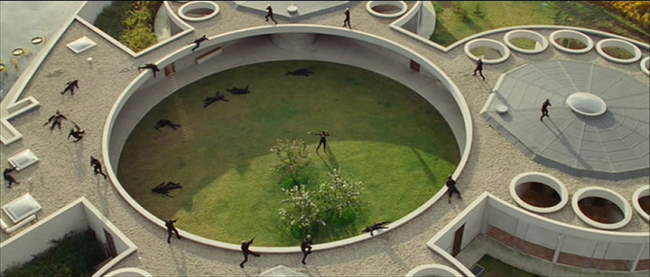
The Visuals: Visually, Aeon Flux is a gorgeous movie. We have also sorts of beautiful futuristic city settings, beautiful characters, and really fun FX. Some of the visuals are completely nonsensical though – the most egregious being an early scene involving Aeon wearing white for the ONLY time in the movie when she wants to stealthily sneak into the Brega compound at night. While this helped make Aeon’s character stand out more, it immediately brings a sense of Hollywood unreality to the whole affair. Still, while many of the action scenes didn’t make lots of sense, they were all nicely shot. Some of the fights were pretty gritty, but for the most part, the resembled a gun-version of a kung-fu dance movie.
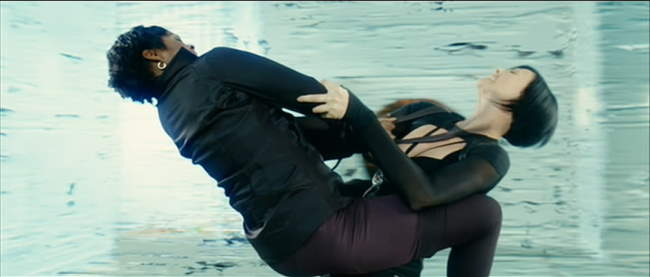
Lots of Hawt Chick Fighting! One of the better aspects of Aeon Flux involves the massive amounts of hawt chick fighting! Yes, its low-brow, but we like it. We get some really juicy fights between Aeon and Sithandra, and Aeon and Trevor’s bodyguard, Freya (Caroline Chikezie). And of course we have massive amounts of Charlize Theron in tight black spandex, kicking butt. While some have compared this aspect to Catwoman, the comparisons are unfair in that 1) we don’t have Mouseketeer ears, 2) all the fighters are very athletic, unlike Sharon Stone in Catwoman, and 3) the fight choreography is far far better.
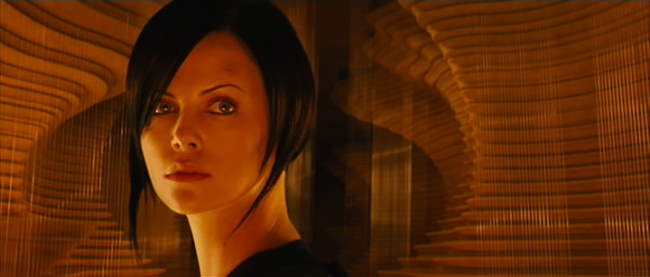
The Bottom Line: While there enough to like in Aeon Flux to give it a passing grade, I really can’t give it more than that. A movie version of Aeon Flux should have been a creative, postmodern event that stayed true to the cores of the characters in the cartoon. Evidentally, the studio thought an innovative approach such as this wouldn’t fly with the vast movie-going public. What was created instead, even though different, could have been decent, but was mired down with horrid editing choices and incoherent motivations in the later half of the story. In the end, it’s hard to buy a number of the decisions various characters made.
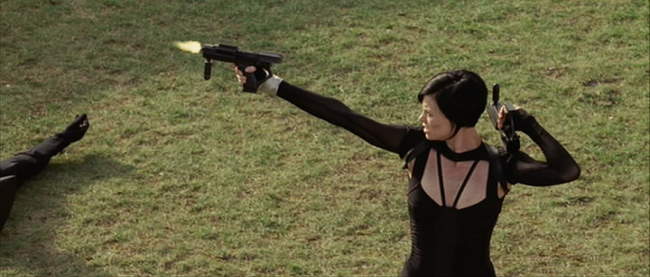
However, the narrative problems in Aeon Flux may be due more to ridiculous studio meddling than with the actual script – apparently the editing was one casualty of studio meddling. Phil Hay has indicated that he will write an essay on how the Director’s Cut would have been different. He is hoping that DVD sales will be high enough that the studio will agree to release the Director’s Cut, which he claims is a very different movie. Still, Charlize Theron’s excellent acrobatics makes for good eye candy, and turns in a credible performance as a humanized version of Aeon (the Trevor portrayal is completely uncrecognizable from the cartoon though). The visuals are terrific, and the technology is pretty interesting. Similar to other 6 star movies that are high on visuals but have problematic stories (Ultraviolet, T3, Appleseed), you may still be interested in giving this a watch.
~See movies similar to this one~
Movie Review By: SFAM
Year: 2001
Directed by: Sogo Ishii
Written by: Sogo Ishii
IMDB Reference
Degree of Cyberpunk Visuals: High
Correlation to Cyberpunk Themes: Medium
Key Cast Members:
Dragon Eye Morrison: Tadanobu Asano
Thunderbolt Buddha: Masatoshi Nagase
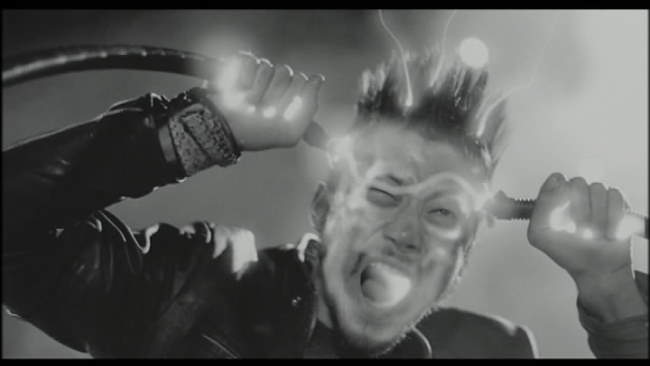
Overview: Sogo Ishii, master of the Japanese Extreme Cinema delivers a truly bizarre experience for us in Electric Dragon 80,000V. If you added the dialogue from this whole movie up, you probably wouldn’t get much more than a page or two. The story is told through visuals, and that said, the narrative itself isn’t all that deep. So why do I give the movie a decent rating? Simple – the visuals and the overall mood this film creates are absolutely unique. Electric Dragon 80,000V is first and foremost an experiential flick. The narrative definitely takes a back seat to the visual and sound integration.
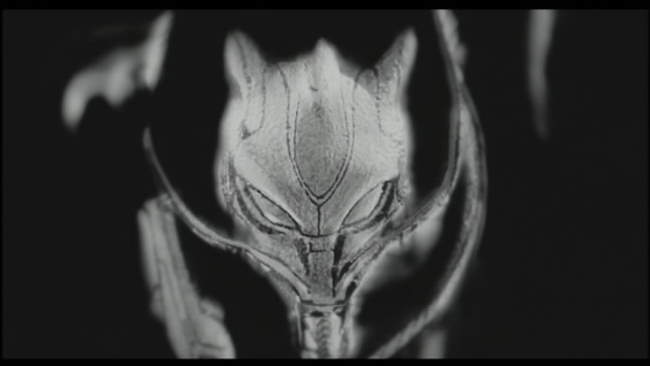
The Story: Electric Dragon 80,0000V follows the maturation of two kids who had traumatic experiences with electricity when they were young. One, Dragon Eye Morrison (played by Tadanobu Asano, who also stars as Kakihara in Ichii, the Killer), underwent electric shock treatment due to being violent as a kid – specifically, he endured 80,000 Volts of electricity. When Dragon Eye Morrison undergoes electric shock treatment, something in his reaction awakens the Dragon. The Dragon is the Eastern style dragon – one that’s embedded in all living things and the world at large. Dragon Eye Morrison’s connection with the dragon releases the rage within in, and thus, forces him to get more shock treatments. With each electric shock treatment, he develops a deeper connection with the dragon. By the time he’s an adult, Morrison can commune with reptiles (he owns a bunch), and has learned that playing REALLY LOUD guitar music (well, playing really loud anyways) is able to sooth the rage within him.
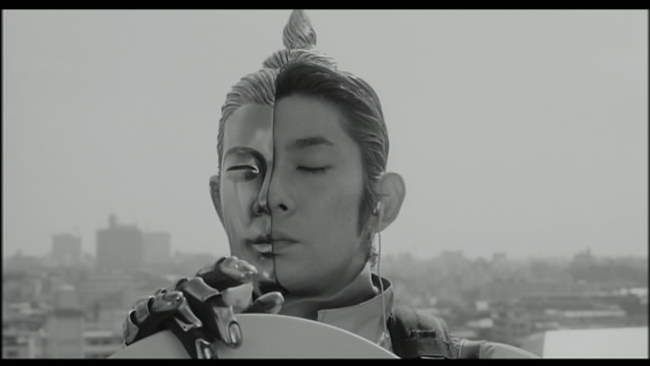
The other, Thunderbolt Buddha (Masatoshi Nagase) got electrocuted with 20 million volts while attempting to climb a power-line tower. The electricity is so high that half of his body becomes encased in metal – and in fact his personality is as split as his body. One side of him is trying to kill himself, while the other is deviously listening in on all electric conversations within his vicinity. It’s not to hard to figure out that Thunderbolt Budda is the bad guy in this modern Godzilla story.
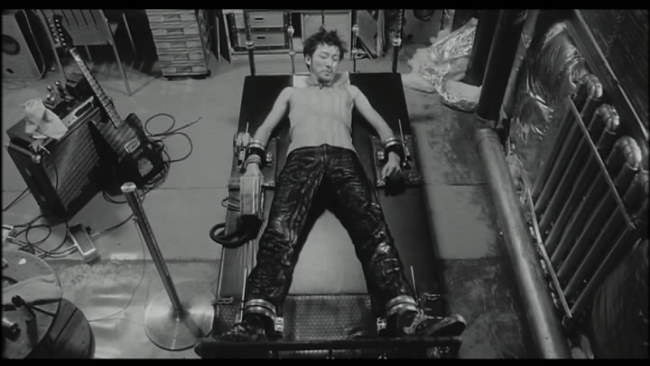
By the time they are both adults, somehow Thunderbolt Buddha, who spends his time attached to a satellite dish, scanning the city, finds out about Dragon Eye Morrison – worse, he decides that the world isn’t big enough for the both of them! So Thunderbolt invades Morrison’s apartment and kills some of his lizards and takes others prisoner. Sure enough, Dragon Eye Morrison figures out who the culprit is and they meet at high noon! From there – it. is. ON BABY!!!!
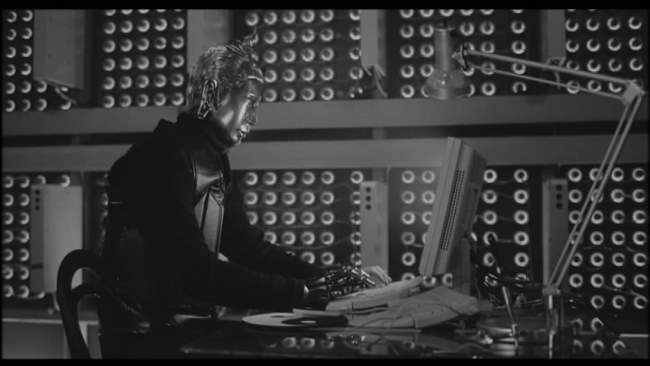
What the Fuck is This Movie About? Yes, at first glance, this movie appears to be pretty shallow and non-sensical, and it may just be. But I like deeper meanings, so allow me to intuit. OK – assuming there is any meaning one can derive from this movie, my wild ass guess is it is this – Dragon Eye Morrison represents the Dragon on earth personified, whereas Thunderbolt Buddha represents modern technology. At first glance, modern technology appears stronger than the earth (20,000 volts to 80,000), yet, due to his ability to bring the full might of the dragon to bare, he’s able to stand up to modern technology. What’s interesting about this theory is the reversal of fortunes: Dragon Eye Morrison gets transformed to merging with the Dragon (earth) due to the detrimental use of technology on him, whereas Thunderbolt Buddha is transformed by a natural occurrence – lighting. In a sense, both grow up reacting against that which transformed them. Or, um, my theory is full of bunk – you make the call. 
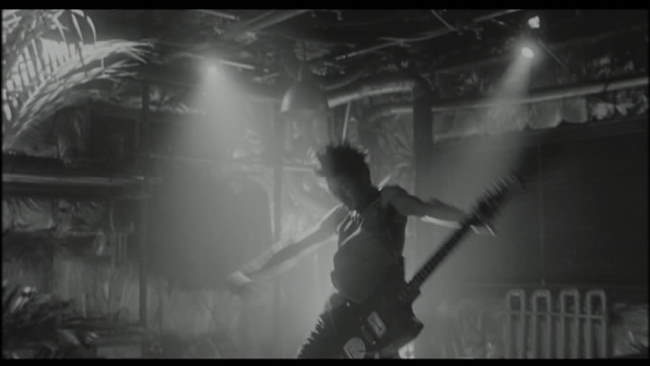
The Sound: As tightly integrated as can be, Electric Dragon 80,000V links massively loud and distorted guitar sounds with the kinetic visuals. This is really the true genius of Ishii’s work. Like all Japanese Cyberpunk movies, Electric Dragon provides an assault on the senses. Unlike most, the assault in this case isn’t as strong on notion of humanity itself, but is instead an assault on you, the viewer. To really experience this movie in the way it was intended, I STRONGLY recommend absolutely cranking the sound. If you don’t do this, you really will lose out on the mood this picture tries to set, and really, will not get the attraction
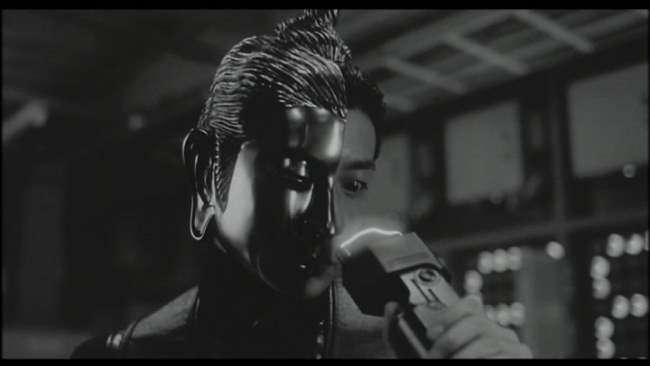
The Visuals: Electric Dragon 80,000V is really rather sedate for the first half. While well shot, the visuals aren’t really that noteworthy from a Japanese Cyberpunk standpoint. But the second half is FILLED with a bevy of truly bizarre shots. Electricity integrated with humans is the theme, and it is explored in a variety of ways, though showing various forms of electricity to kinetic shots of volts coursing through our lead characters. The second half uses the same style of stop-motion animation we get in Tetsuo - The Iron Man. While the movies are radically different, the movement of these two films is pretty similar.
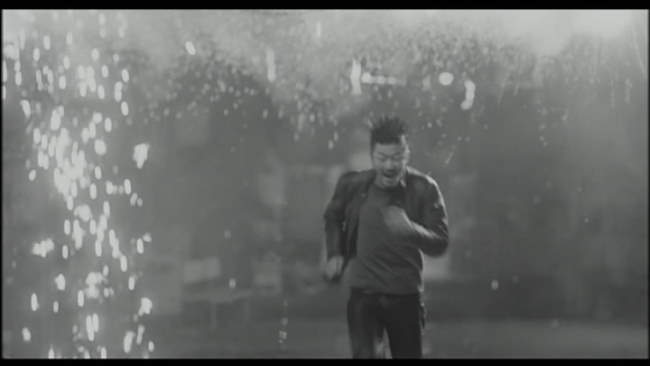
The Bottom Line: Electric Dragon 80,000V is clearly an indulgence in extremes. The mood brought on by the sounds and visuals far outweighs what little exists of the narrative. In the end, Electric Dragon 80,000V is either a movie you really dig or absolutely abhor. For this reason, I find it pretty difficult to give a solid rating, so I’ve gone with 7 stars - which implies that it’s a good movie, but one that some may not like. The entire thing is barely 50 minutes, so if you find yourself hating it, not to worry, it will be over soon. If you do like it though, Electric Dragon 80,000V has solid replay value.
~See movies similar to this one~
Movie Review By: SFAM
Year: 1993
Directed by: Fred Dekker
Written by: Frank Miller & Fred Dekker
IMDB Reference
Degree of Cyberpunk Visuals: Medium
Correlation to Cyberpunk Themes: Low
Key Cast Members:
RoboCop: Robert John Burke
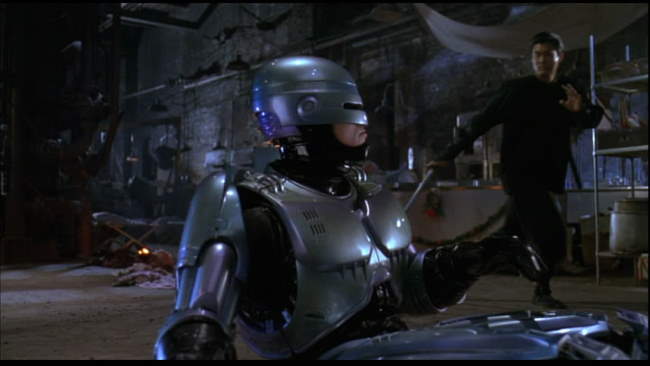
Overview: The first Robocop movie was an absolutely terrific, innovative flick. Robocop 2 really sucked, but not as bad as Robocop 3. All pretense of putting together a decent movie goes away in Robocop 3. Peter Weller, who plays Robocop in the first two movies wisely skipped this piece of shit. The only remaining cast members from the first are the Police Captain, Officer Lewis (Nancy Allen), the stooge corporate dude, Johnson (Felton Perry). Of these, only Officer Lewis had any chance of carrying a decent amount of heft for the show, but she is prematurely bumped off without reason, and the other two are pretty much just caricatures of themselves. In short, Robocop 3 is a pure, low-budget trashy sellout made for 8-14 year-olds who were familiar with the G-rated series - the plot goes for the young genius hacker kid and ninja bad guy vice attempting to work up a real plot.
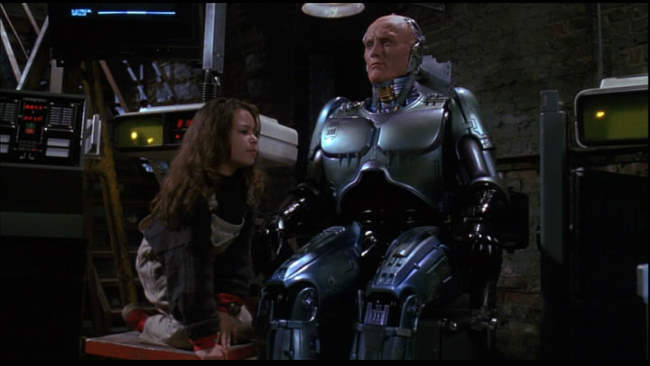
The Story: Like Robocop 2, OCP is still trying to create a massively expensive city in a place that only has the destitute poor. God knows why, as nobody will be able to afford ANYTHING created, but we’re just supposed to go with it. In this episode, we have the nasty Japanese buying up OCP and hiring a cheesy security firm to simply gather up all the poor people and ship them out to concentration camps. But Robocop doesn’t like this, and decides he no longer feels like obeying his prime directive that stops him from challenging OCP employees. Instead, he joins a ragtag resistance comprised of local yokels, the genius kid, and of course his sympathetic OCP scientist care taker. But wait! There’s more! The evil Japanese have sent a cyborg ninja to kill Robocop. Ohhhhhhh – you can just cut the tension with a plastic spoon!
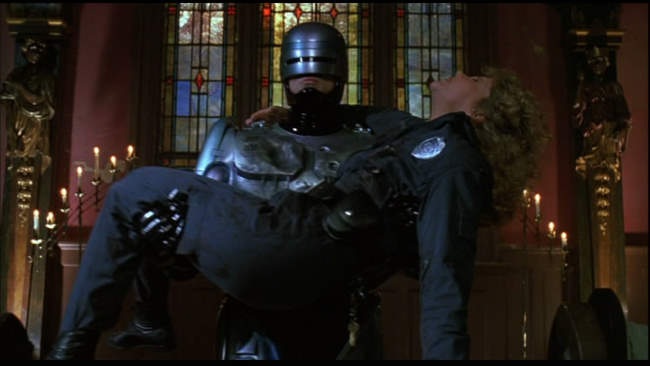
The Bottom Line: Honestly, I have a hard time seeing how Frank Miller is in any way responsible for the screenplay for this piece of trash. It’s pretty sad to see the Robocop movies end in such a trashy way. Yes, there is another kiddie miniseries that follows this, but truly, Robocop should have stopped after the first. This franchise is the poster child for Hollywood fuckups. In thinking about it, they could have done quite a lot with the Robocop universe, and potentially even could have done interesting things with the original Robocop character. Instead, they choose the cheesy derivative path. This led to both less money and the painful death of the cash cow.
~See movies similar to this one~
Movie Review By: SFAM
Year: 2004
Directed by: Shinji Aramaki
Written by: Masamune Shirow (Manga), Haruka Handa & Tsutomu Kamishiro (screenplay)
IMDB Reference
Degree of Cyberpunk Visuals: Very High
Correlation to Cyberpunk Themes: Medium
Key Cast Members:
Deunan Knute: Ai Kobayashi
Briareos: Jûrôta Kosugi
Hitomi: Yuki Matsuoka
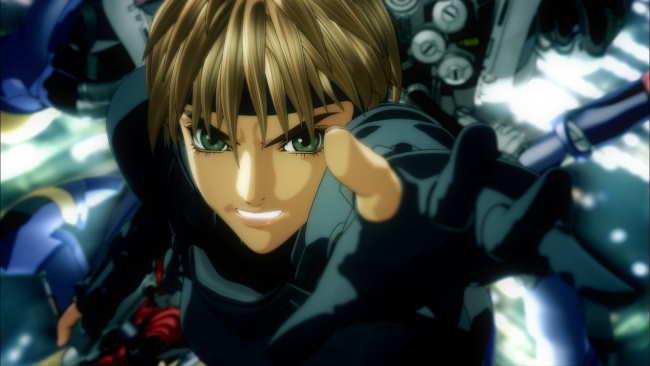
Overview: Masamune Shirow’s Appleseed recently got a second anime treatment. The last was in 1988 – this time, in 2004, the anime is done up in eye-popping 3D graphics. With a budget of only 10 million as compared to over 90 million for a movie like The Incredibles, we shouldn’t be expecting too much. Surprisingly, we get far more than expected, especially with regards to the wonderfuly rendered backgrounds. While the animation is interesting enough, the story is more problematic. So too are the change in the feel of the characters. This is really where the original version succeeds far better than Aramaki’s version.
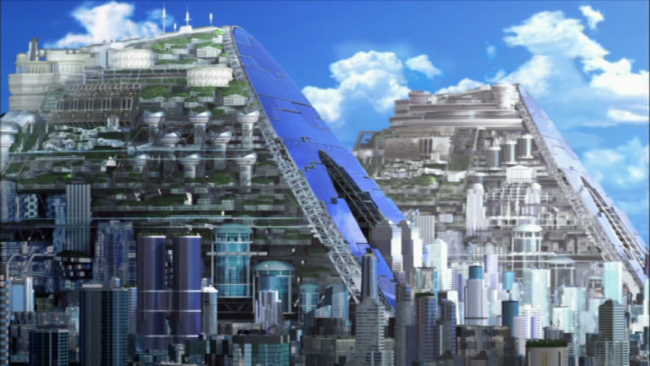
The Story: Appleseed takes place in the year 2131, a war-ravaged dystopian future where most all of human society is in ruins. Over two years after the last war, the only example of advanced human civilization is a newly made city called Olympia, which has been engineered to be a created as a perfect refuge from the rest of the world. Over half of the city’s inhabitants are comprised of bio-engineered “biodroids,” which are human-like beings designed to serve specific roles in the society. An all-knowing computer named GIA supports the city council in controlling all aspects of city life.
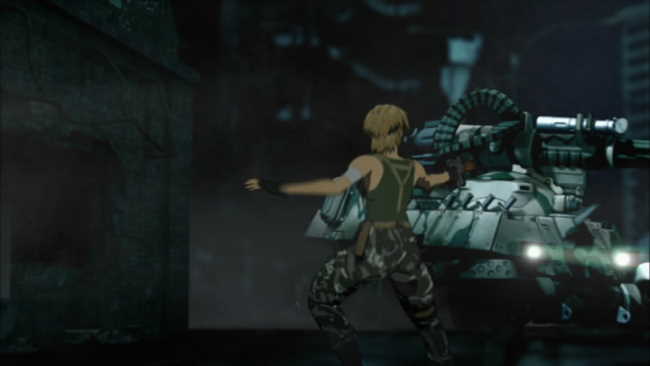
Deunan Knute, a fighter extraordinaire has been living alone in the wastelands, not realizing that the war is over. She is beset by two warring groups of fighters, one of which who is trying to kill her, and the other group, which rescues her and takes her to Olympia. There she is re-acquainted with her long lost lover, Briareos, who now has been transformed into a cyborg after his body was lost in the war. She is tasked to join “ESWAT,” a special mecha-enabled police force that keeps order within the city. Deunan also befriends a biodroid named Hitomi, who shows her around the city. Unfortunately, Deunan barely gets a chance to settle down before the assassination attempts on her life start.
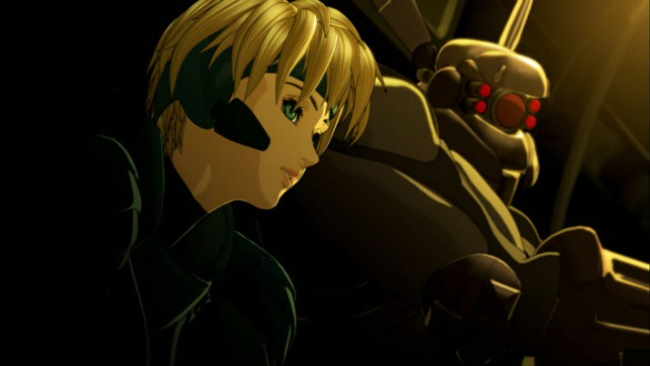
Duenan quickly learns that she has been dropped in the middle of a power struggle between humans, who are concerned that the biodroids secretly aim to exterminate them, and biodroids, who worry the same about the humans. Somehow, Deunan has become essential in this struggle, yet it has nothing to do with her fighting capabilities. It turns out that her parents, before dying, developed a method for biodroids to reproduce, which would make them almost exactly like humans. But this research was lost long ago. Now, Deunan has become a pawn for both sides of this struggle, and worse, it appears as if her ex-lover, Briareos has chosen sides.
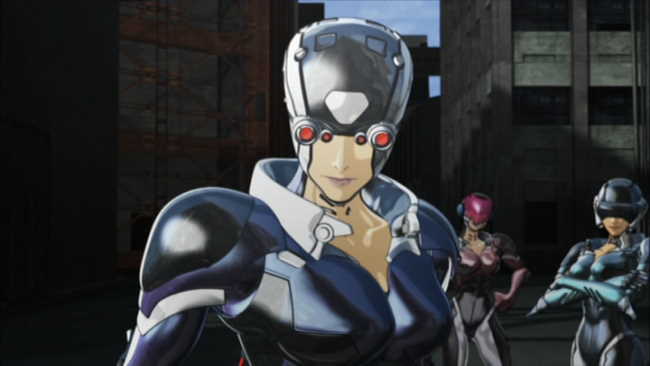
Unfortunately, the story in this version of Appleseed is problematic at best. There are too many sub-plots that obfuscate the key points. The myriad of loose ends introduced that are never followed up on. Gia, the sentient computer that runs Olympus is the probably the worst casualty. We get introduced to her, and, if you know something of the Appleseed story from the Manga, you expect to see lots more than what actually ends up being conveyed. In the end, the plot centers on a simple theme of racism. This is a shame as there were so many interesting cyberpunk aspects of Olympus that get short-circuited.
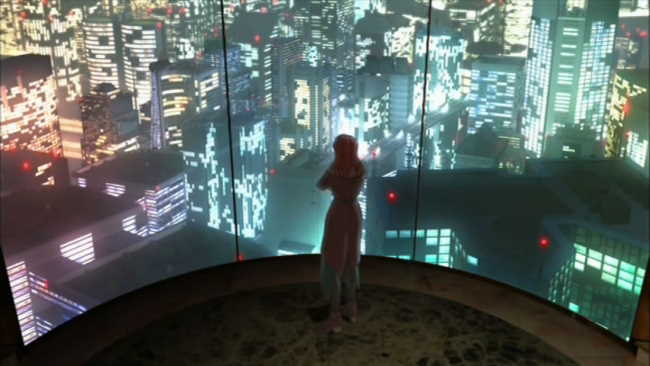
The Animation: Appleseed’s backgrounds are wonderfully rendered. This more than anything accounts for the majority of the “wows” Appleseed received. They are done in a way that allows 3D camera maneuvering, so as to allow you to see the same scene from multiple angles, and at times, even provides Matrix bullet-time effects. For the most part, the 3D CG overlaid with 2D cell shading really works. It’s an extension of the idea we saw in Malice@Doll, only with far better rendering tools. The machines look especially awesome. Both the Gunhed style tanks at the beginning of the movie and the platform sentinels at the end. Unlike many cyberpunk movies, there isn’t a dominating color palette in Appleseed, but the color scheme seems to stick more often than not to light and dark shades blue-greens, with yellow & browns in transition scenes.
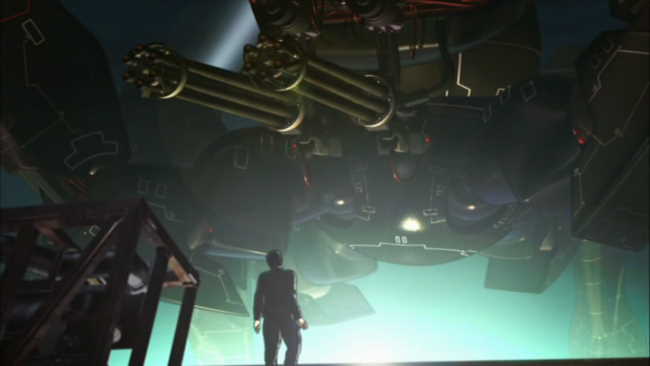
In terms of the characters, only Deunan Knute really looks polished. Her body movements, facial expressions and general actions really work. The rest, especially the human characters, often look stilted in their moments. Hitomi, their biodroid friend, is especially problematic at times. This might be due more to the motion-capture techniques they use, which work wonderfully for the city, but not so well for the characters. Also, I really dislike the way they animated the hair. The hair on the humans in the 2004 edition look like something out of Reboot. However, considering the budget, I think they made the right decision in spending scarce resources on Deunan. Had they just made everyone look slightly better, Appleseed would have faltered horribly. By at least making Deunan polished, they developed a star that fit right alongside their wonderful backgrounds.
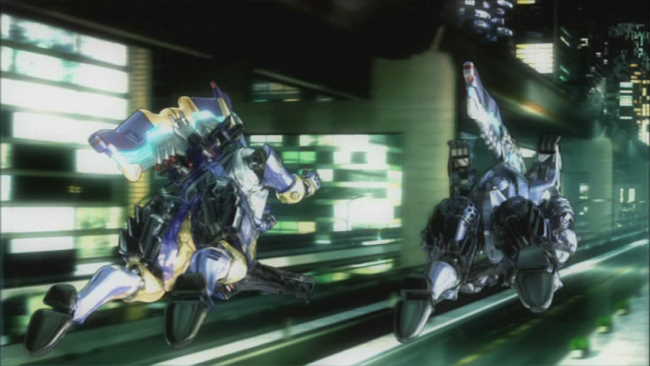
The Sound: Many times throughout the anime, Appleseed plays more like a music video than it does a movie. The modern heavy rock beats worked well for the action scenes. And truly, the action scenes are where Appleseed excels. There, the 3D positional sound, the music accompaniment and the 3D CG graphics are at their absolute best. The accompanying score really wasn’t all the memorable, but at least served up the slower paced moods fairly well.
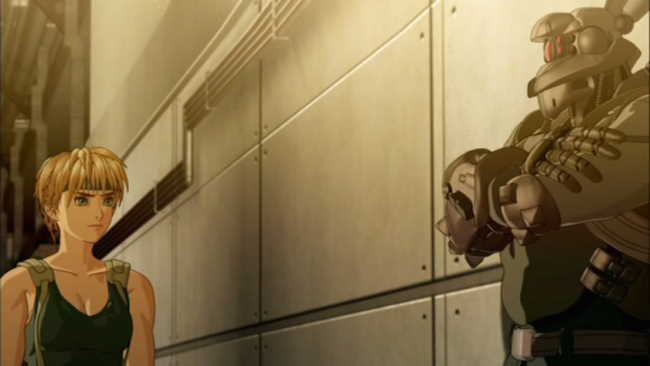
Differences From Shirow’s Work: While both animes deviate from Masamune Shirow’s Appleseed Manga, Aramaki’s version is the most egregious. While the 2004 version starts outside of Olympia as the Manga does, it only has Duenan there, whereas in the Manga has both. This version introduces a new dramatic twist of Duenan and Briareos getting back together for the first time in two years. While this in itself isn’t bad, the side-effect is: these two characters are no NOTHING like the Manga. The Duenan Knute and Briareos of Shirow’s Manga, and of the 1988 version, are precursors to the Ghost in the Shell’s Motoko and Batou. Here, Briareos is a moody, lost soul trying to deal with his cyborg body, and Duenan is far more vulnerable than tough. The playful chemistry we see between these two both in the Manga and the 1988 anime is completely missing here. For those who aren’t familiar with the Manga, this probably won’t bug you, but it certainly sapped some of the enjoyment out of this movie for me – so much so that I’m dropping a star off the review for it.
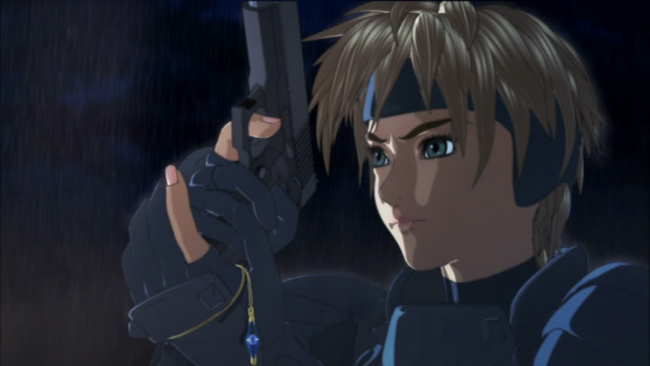
The Bottom Line: Appleseed is definitely worth seeing for the visuals alone. While some of the characters don’t work, the Duenan, the machines and the action scenes work wonderfully. Unfortunately, the story doesn’t equal up. Too many elements are introduced and then discarded in favor of a truly simplistic storyline. They could have done better. Also, as I mention above, this is not the Deunan and Briareos I’ve become familiar with – these characters are different from both the Manga and the earlier anime. This bugged me enough to drop a star from the review, but you might not mind so much.
Page 2: More Screencaps –>>
~See movies similar to this one~
Movie Review By: SFAM
Year: 1999
Directed by: Scooter McCrae
Written by: Scooter McCrae
IMDB Reference
Degree of Cyberpunk Visuals: Low
Correlation to Cyberpunk Themes: Medium
Key Cast Members:
Ginny Chin-Chin: Jane Chase
Adrian Torque: Crawford James
Alik Silens: Alice Liu
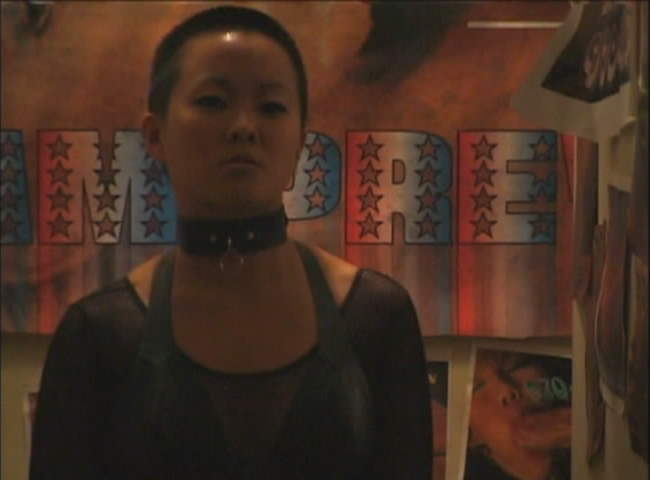
Overview: WTF!!! That pretty much sums up Sixteen Tongues. This low-budget softcore cyberpunk porn flick has potential in some of its thoughts, but just loses out in editing, movie making basics like clear dialogue and pointless filler scenes. Low budget flicks often free the director to stop paying attention to movie conventions and potentially create something unique. But to make this pay off, some of the basics of crafting still need to be worked.
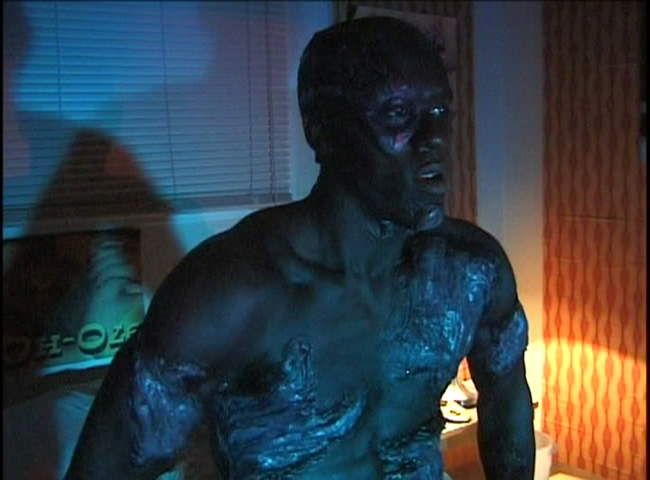
The Story: In a dystopic, seedy future, where humanity is fleeting, Sitxteen Tongues follows the plight of three emotionally scarred people (one physically scarred as well). Adrian (Crawford James) is a severely scarred police officer who seemingly died in a previous conflict, but was brought back to life, and had his damaged skin repaired by replacing it with sixteen tongues. His tongue skin, which forces him to taste his own clothes and everything he touches, has since made him go crazy – he hears voices and every now and then, and randomly goes on murderous rampages. Ginny Chin-Chin is a bio-modified assassin droid who has had sexual implants causing her to organism every time she blinks her eyes. The implants help her resist the urges to kill, but she still is driven to find her maker and rip him into shreds. Alik is a hacker extraordinaire, and is Ginny’s lover. She spends her time trying to find Ginny’s maker, but also has the ability to user her equipment to ghost-hack into other’s minds.
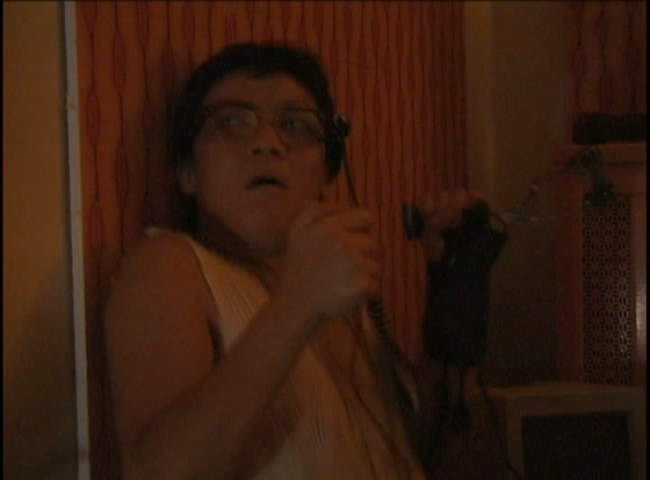
All three characters are emotionally traumatized. Alik and Ginny spend half the movie fighting about whether they really care for one another. Adrian is caught up in his own paranoid delusions. Through a chance encounter to get ice, Ginny and Adrian meet up. Ginny goes to his room (which has porno films playing non-stop) and finds out he’s a cop. She thinks he can help her in finding her maker, so she gives him oral favors in exchange for potentially helping her. While Ginny is having sex with Adrian, Alik hacks into Adrian’s TV signal and watches them. More arguments ensue.
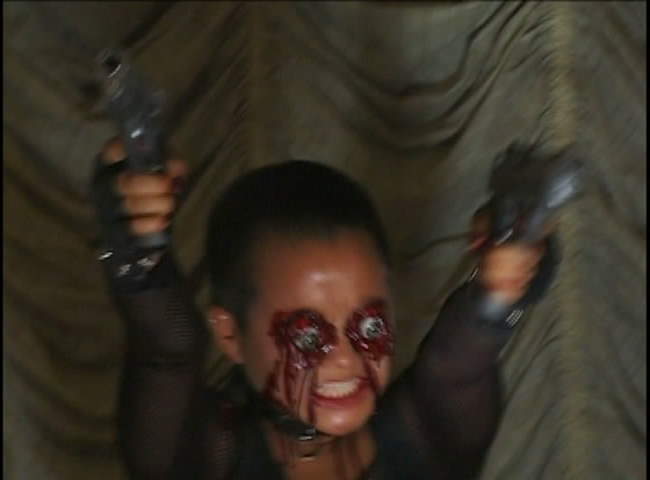
Eventually things come to a head due to Adrian’s paranoid delusions. In scanning Ginny’s bar-code, he knows she is a dangerous murderer, and for some reason, begins to think Ginny is actually responsible for his murderous rampages. Confrontations occur, and things spiral out of control from there.
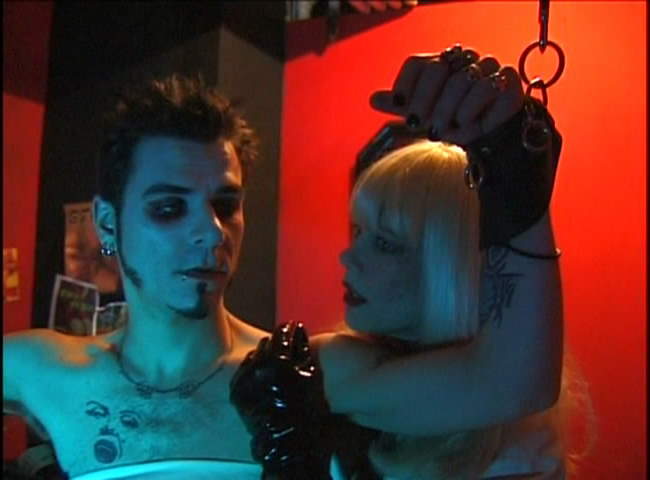
The Set: The entire movie takes place in a few rooms in a seedy hotel with porn posters covering all the walls. The hotels don’t look at all futuristic, aside for the credit card swap machines everywhere. They do at least look very seedy and lived in, although the random people sleeping on the floor was probably overkill. Also, we eventually learn that complete sexual deviants fill virtually every hotel room.
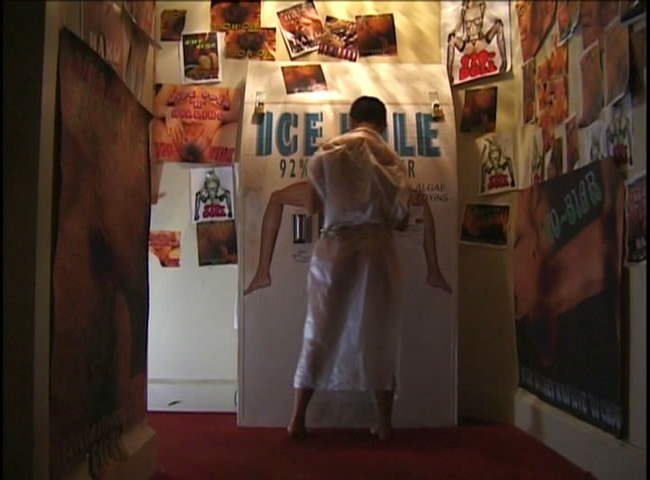
Picture slightly airbrushed out in obvious places. Go here for original.
The Nudity: Fair warning – Ginny Chin-Chin spends well over half the movie either in the buff, in a sheer shower-stall plastic outfit, or in her fishnet get-up. She definitely looks hawt in this, whereas Alik, also nude some of the time, is made to look as nerdy as possible. In addition, we are treated to other random nude chicks we see as the movie progresses. Blood and gore are also in high supply here.
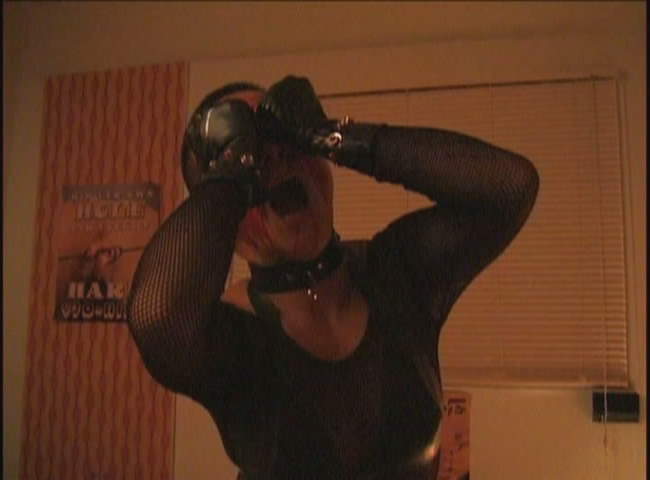
The Props: While at first glance, this movie borders on hard core by having an oral sex scene, if you look closely (or watch the extras), you can see that this is a prop. The dildo prop has various warts on it and spurts blood. Adrian’s facial skin grafts look pretty cool, and generally look like a part of him. Alik’s hacker tools, while extremely low-tech, at least pass some minor degree of believability.
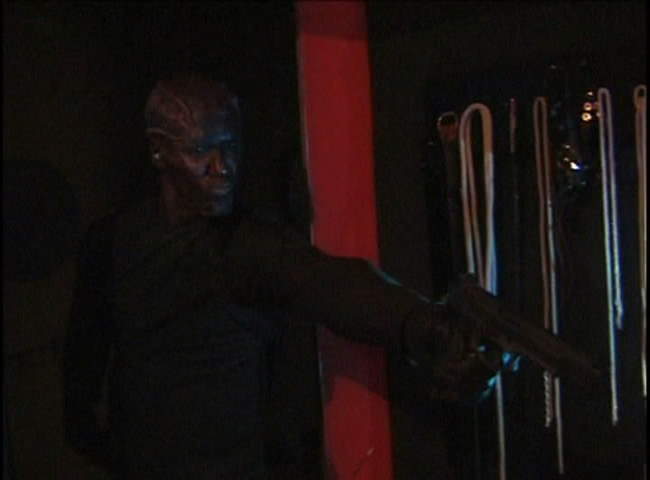
The Sound and Lighting: If there’s a place that Sixteen Tongues falls flat on it’s face, it’s the sound. The actors are clearly not that experienced, and tend to mumble their lines. Worse, McCrae, the director, doesn’t seem to mind. With this combination of poor quality sound reproduction and mumbled lines, the viewer is left to decipher the dialogue in many of the scenes by watching reactions. Adrian and Alik are the worst at this. There are a few scenes of each where the view has no possibility of figuring out what is said. The lighting is also atrocious. Constantly we get over-exposed actors or actors completely blotted out by a bright light behind them.
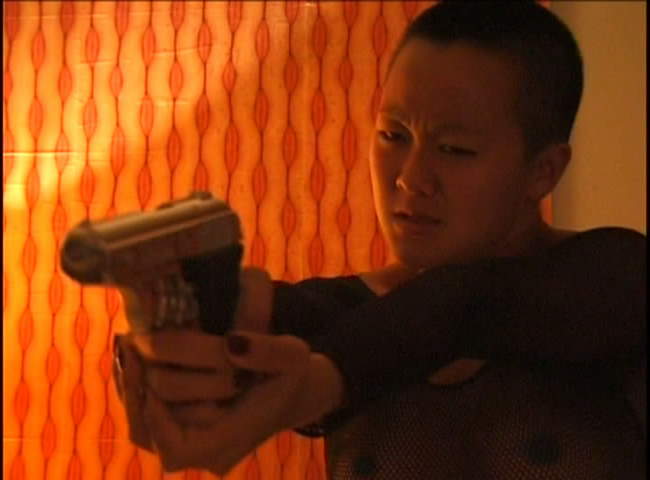
Picture slightly airbrushed out in obvious places. Go here for original
The Bottom Line: Some of the ideas with Sixteen Tongues are pretty interesting. The hacker approach is very similar in some ways to Neuromancer in that it really doesn’t seem to recognize a modern internet, but instead goes towards this almost inaccessible cyberspace that only specialized hackers can use. Unfortunately, some ideas, including the Android assassin bit, and the briefly mentioned bacteria-taking over the body and mind bit are barely even explain. While the plot is problematic and the acting sub-par, it’s the basics – lighting, editing and sound that really doom Sixteen Tongues. Again though, Jane Chase as Ginny Chin-Chin does look pretty smokin in her various get-ups. So if you want to see a bizarre, edgy, low-budget approach to cyberpunk with lots of nudity and gross scenes sprinkled throughout, you might get some enjoyment out of this.
~See movies similar to this one~
Movie Review By: SFAM
Year: 1993
Directed by: Sumiyoshi Furakawa
Written by: Yasushi Hirano (story), Kazumasa Hirai & Jirô Kuwata (characters)
IMDB Reference
Degree of Cyberpunk Visuals: Low
Correlation to Cyberpunk Themes: High
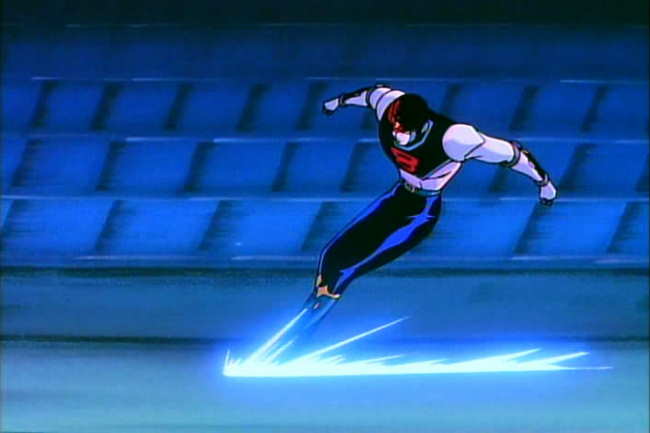
Overview: If you’re hankering for a sequel to Robocop, skip the live action sequels, and instead get 8 Man After. You won’t get the best animation, but the story itself is more than passable. The characters aren’t all that deep, but they’re interesting enough to keep your attention. This OVA, which on the DVD is presented as a film, seems to rise above the obviously meager animation budget to produce a decent product.
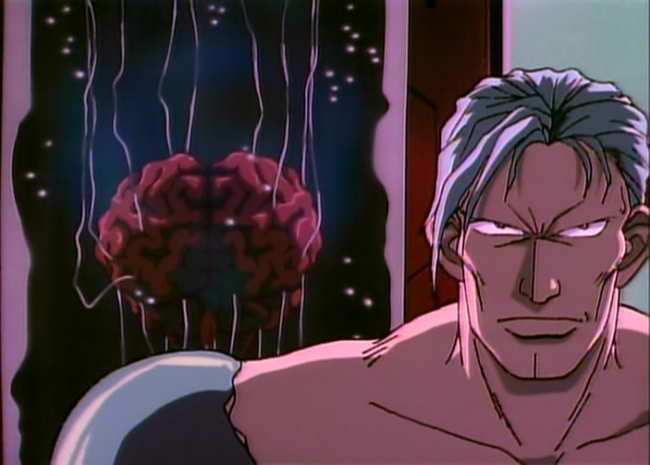
The Story: 8 Man After is a sequel to the 1960s TV series called 8th Man (I have not seen the original). In 8th Man, a cop dies, is revived, and is given a cybernetic body that can move lightning fast. He uses it to confront a cyborgs crime lord in similar circumstances, but is later killed. His girlfriend, Sachiko Yokogawa, never learns what happens to him. Since then, petty criminals with cybernetic implants have started to rule the streets. The police are outgunned, and decide they need a special edge – so they decide to revive the 8 Man.
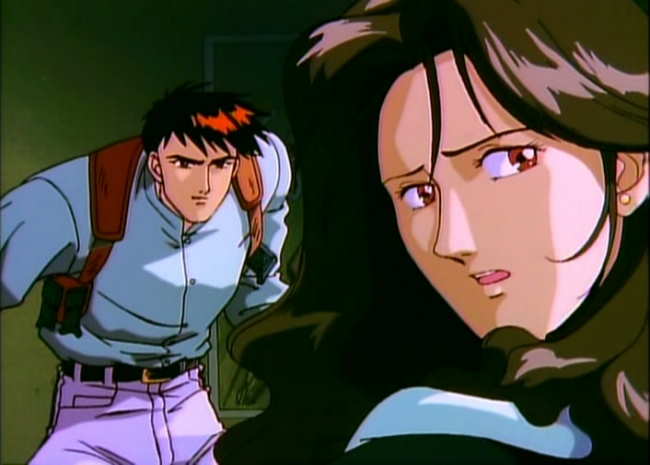
In 8 Man After, a similar situation occurs as in the original – this time, police detective Hazama Itsuro, an emotionally fragile cop, meets up with Sachiko on a chance encounter, and they begin to fall in love. But fate intervenes, and a nasty criminal with cyborgs implants comes to kill them. Hazama is able to defeat him, but seemingly dies in the process by falling out of a high story window. Hazama is revived when the police take Hazama’s brain and insert it into 8 Man’s body.
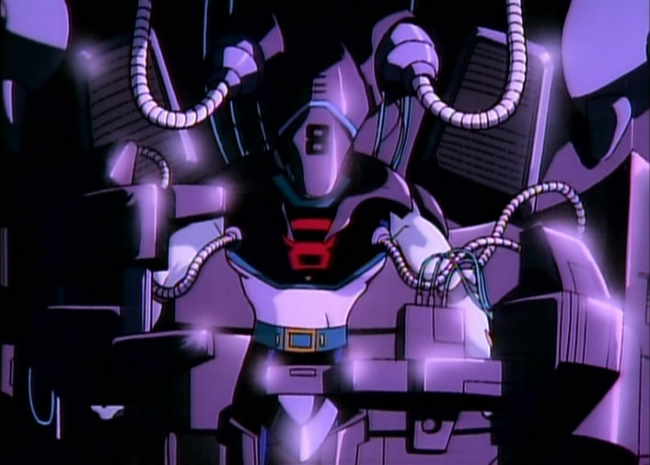
Hazama can now move lightning fast, and due to technical reasons, is the most advanced cyborgs on earth. He begins to fight the bad guys, but unfortunately, it turns out that his emotional troubles cause him to occasionally lose control over his actions. This is complicated by Hazama’s continuing relationship with Sachiko, who does not know what he’s become. Things come to a head when Hazama/8 Man goes up against the crime lord while trying to rescue Sachiko.
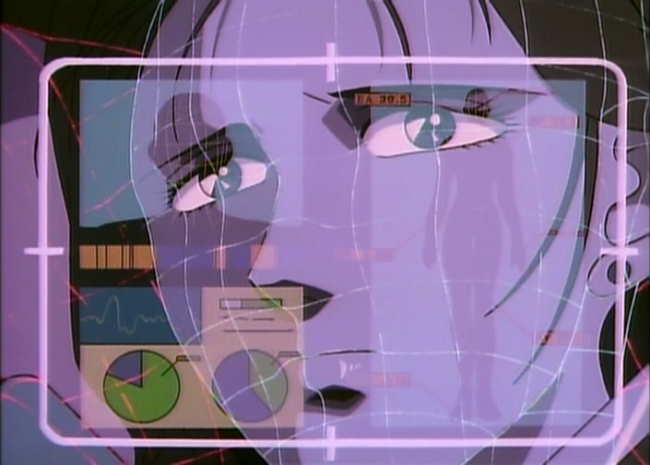
This is a “Who am I?” Story: 8 Man After does a decent job of going over established ground in that it questions whether a brain inserted into a cyborgs host is still human. The complicating twist in 8 Man’s case is that his emotions end up making him temporarily lose control over his body, and in fact, lose awareness over certain events. The added relationship aspect, where Sachiko has now fallen in love with two people who end up losing their bodies is sort of interesting as well. Again, there’s nothing really new here, but it is well done.
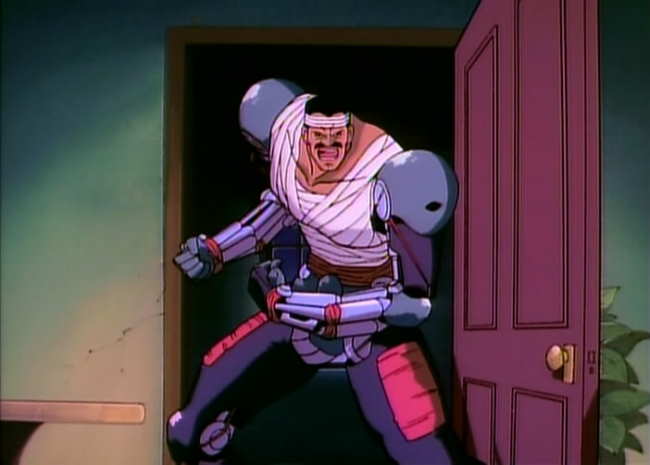
The Animation: At some level, animation of this quality, five years after Akira is surprising. Many of the shots look like straight Saturday morning cartoon fodder. Every now and then, we get a terrific shot or two, and sometimes get an innovating looking camera approach, but for the most part, you get simplistic backgrounds, very basic character designs, linear movement, and lots of pan and scans of stills. Worse, you also get some repeated 8 Man after streaking shots. Without an absolutely kickin story (which it has), 8 Man After just wouldn’t be worth the time.
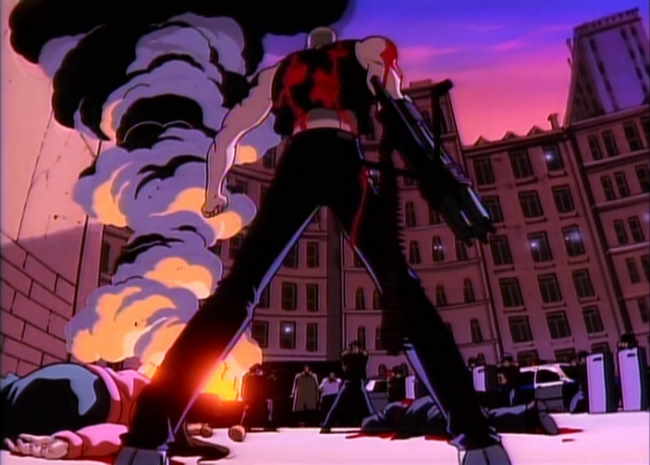
The Violence: Like Robocop, 8 Man After is very violent. However, the animation isn’t good enough for this to really matter all that much. There is lots of blood and killing which is usually don’t in the context of a motivating story, but it just doesn’t have the impact of many violent animes. Even if you can’t stomach violent story lines, you will probably be OK with 8 Man After.
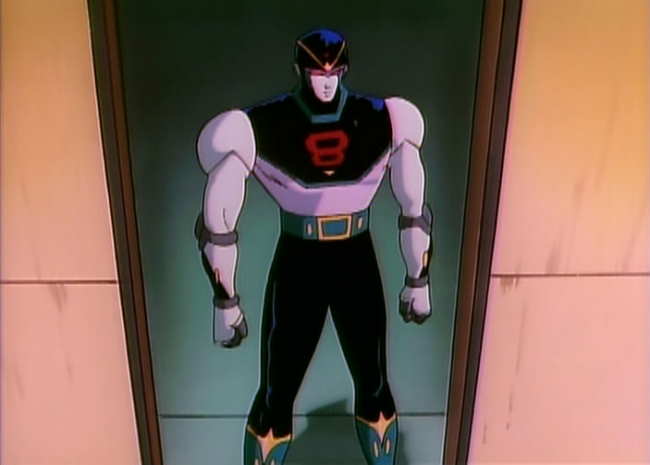
The Bottom Line: OK, the animation isn’t the greatest, but the story is pretty good – FAR better than the Robocop sequels. The sub-plot of the son with a burnt-out cyborg father is especially well done. If you’re looking for a Robocop-like examination of humanity, animated from the cyborg’s perspective, 8 Man After is a decent choice.
~See movies similar to this one~
Movie Review By: SFAM
Year: 1990
Directed by: Irvin Kershner
Written by: Frank Miller & Walon Green (screenplay), Michael Miner & Edward Neumeier (characters)
IMDB Reference
Degree of Cyberpunk Visuals: Medium
Correlation to Cyberpunk Themes: Low
Key Cast Members:
Robocop: Peter Weller
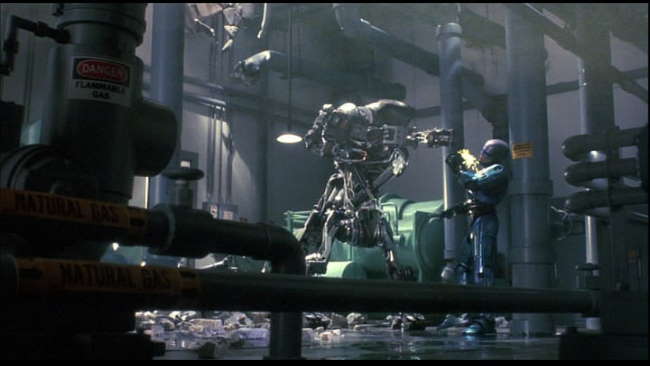
Overview: Oh how the mighty have fallen. In Robocop, we get a violent, satirical look at a future with an interesting story, complete with cyborg musings and incredible visuals. In Robocop 2, we get a tripe, over-the-top monstrosity that devolves into a Godzilla versus King Kong movie. Where Robocop provided a biting commentary on the state of corporate influence and advertising, Robocop 2 settles for a simplistically evil, nonsensical, corporate stooges who are far more interested in screwing society than they are making long term profit. Put simply, Robocop 2 is a mess when compared to its original.
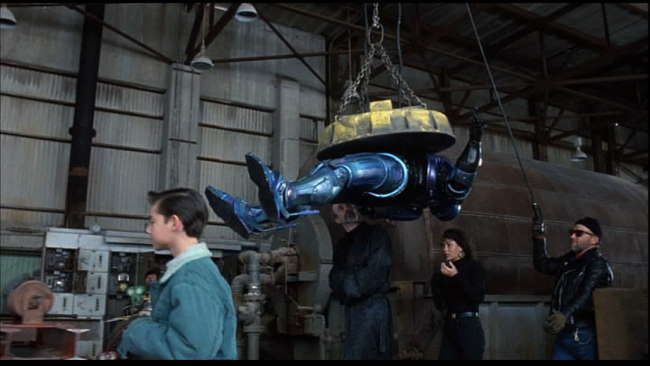
The Story: In Robocop 2, the OCP Corporation is bent on nefariously taking over ownership of the city so that it can squeeze every dollar out of the populace (which, interestingly, is already poor). As part of their plan, OCP tacitly supports the distribution of a new addictive drug called “Nuke.” With the cops on strike and the evil drug lord Cain distributing the drug and destroying the populace, only Robocop is there to protect Detroit from complete anarchy. But even Robocop is removed when a new scheming corporate businesswoman at OCP will do anything to get to the top, including screwing the CEO, ruining Robocop and replacing him with the Nuke drug lord, Cain. I could to into more details, but truly, the plot sucks too much to bother.
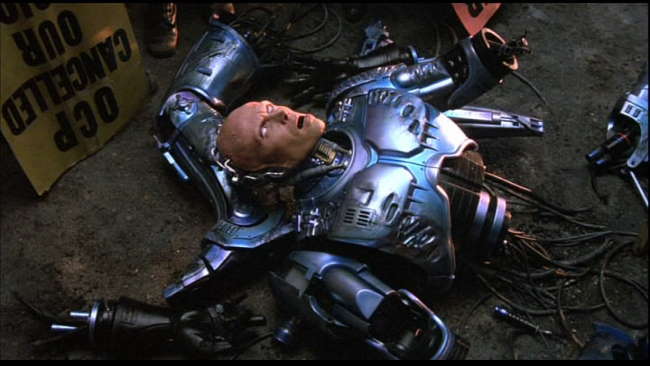
Robocop Stripped: “Christ, he’s been stripped,” is the line the policeman delivers upon seeing Robocop as a heap of parts. I couldn’t agree more. The plot points in Robocop 2 are idiotic at best. OK, so the bad guy and his 12 year-old kid beat Robocop. Of course, the logical thing to do is to drop him off, living parts and all at police HQ, right? And of course it makes sense for a Lawyer to control the Robocop project, even though there aren’t any legal issues involved. And just as logical is the corporation that gambles its entire viability on a psycho-maniac dead drug addict to be its corporate face and protector of the public, while destroying its investment in Robocop by programming him with silly parables (Gee, any reason they didn’t just re-assign Robocop to the military?). In topping this silliness, at least we know that Robocop, human brain and all, is able to easily withstand a drop from the top of a skyscraper. Interestingly, Robocop 2 tells us that the most expensive part of running a city is the police department, not the building of an ENTIRE NEW DOWNTOWN, which, we are told, will instantly pay for itself because its population will be paying for an addictive drug! I could go on, but clearly, the plot isn’t supposed to make sense. One wonders what the original script looked like as its pretty clear that Frank Miller’s script was modified significantly.
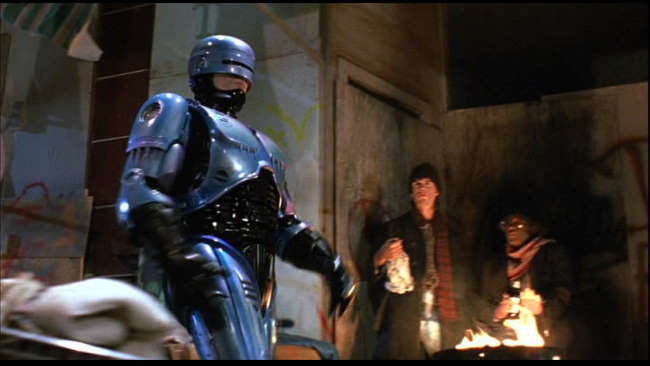
You can tell why OCP wants to steal Detriot to make money of the populace.
Detriot’s citizens are all millionaires!
The Bottom Line: While most of the key characters return (Peter Weller, Nancy Allen, Dan O’Herlihy, Felton Perry), they are joined by a cast that includes a parodied lunatic for a mayor (Willard Pugh), a kid for a bad guy (always the touch of death), and shallow scheming, horrible acting corporate bitch (Belinda Bauer). The interesting questions from the first movie are again posed, but this time in a sophomoric, absurd fashion – so much so that they divorce any interest in the potential answers. The FX, including the stop-motion animation are still decent enough to keep the movie from being a total waste, but just barely. If Robocop was intended as a total goof (meaning the actors realized this), it would have worked better. Instead, we get a story that qualifies as a parody while the actors seem to think they’re making a credible remake. The result is less than stellar.
~See movies similar to this one~
|



























































































